Research Progress of Micro-LED Display Technology
Abstract
1. Introduction
2. Micro-LED Chip Technology
2.1. Epitaxy Technology
2.2. Chip Structure
2.3. Miniature Challenge
3. Mass Transfer and Monolithic Integration Technology
3.1. Mass Transfer
3.1.1. PDMS Stamp Transfer
3.1.2. Laser Transfer
3.1.3. Self-Assembly Transfer
3.1.4. Other Transfer Techniques
3.2. Monolithic Integration
4. Full Color Display
4.1. RGB Three-Color Method
4.2. UV/Blue LED + Luminescent Medium Method
4.3. Lens Synehesis Method
4.4. Special Structure Method
5. Bonding and Driving Technology of Micro-LED Backplane
5.1. Bonding Technology
5.2. Driving Technology
5.2.1. PM Driving
5.2.2. AM Driving
CMOS Driving
TFT Driving
Pixel Driving Circuit
6. Micro-LED Detection and Repair Technology
7. Commercial Application of Micro-LED
8. Conclusions and Future Developments
Author Contributions
Funding
Data Availability Statement
Conflicts of Interest
References
- Virey, E.H.; Baron, N. 45–1: Status and Prospects of microLED Displays. SID Symp. Dig. Tech. Pap. 2018, 49, 593–596. [Google Scholar] [CrossRef]
- Zhou, X.; Tian, P.; Sher, C.-W.; Wu, J.; Liu, H.; Liu, R.; Kuo, H.-C. Growth, transfer printing and colour conversion techniques towards full-colour micro-LED display. Prog. Quantum Electron. 2020, 71, 100263. [Google Scholar] [CrossRef]
- Ryu, J.-E.; Park, S.; Park, Y.; Ryu, S.-W.; Hwang, K.; Jang, H.W. Technological Breakthroughs in Chip Fabrication, Transfer, and Color Conversion for High-Performance Micro-LED Displays. Adv. Mater. 2023, 2204947. [Google Scholar] [CrossRef] [PubMed]
- Anwar, A.R.; Sajjad, M.T.; Johar, M.A.; Hernández-Gutiérrez, C.A.; Usman, M.; Łepkowski, S.P. Recent Progress in Micro-LED-Based Display Technologies. Laser Photonics Rev. 2022, 16, 2100427. [Google Scholar] [CrossRef]
- Parbrook, P.J.; Corbett, B.; Han, J.; Seong, T.Y.; Amano, H. Micro-Light Emitting Diode: From Chips to Applications. Laser Photonics Rev. 2021, 15, 2000133. [Google Scholar] [CrossRef]
- Wu, T.; Sher, C.-W.; Lin, Y.; Lee, C.-F.; Liang, S.; Lu, Y.; Huang Chen, S.-W.; Guo, W.; Kuo, H.-C.; Chen, Z. Mini-LED and Micro-LED: Promising Candidates for the Next Generation Display Technology. Appl. Sci. 2018, 8, 1557. [Google Scholar] [CrossRef]
- Chen, Z.; Yan, S.; Danesh, C. MicroLED technologies and applications: Characteristics, fabrication, progress, and challenges. J. Phys. D Appl. Phys. 2021, 54, 123001. [Google Scholar] [CrossRef]
- Henry, W.; Percival, C. 55–2: Invited Paper: ILED Displays: Next Generation Display Technology. SID Symp. Dig. Tech. Pap. 2016, 47, 747–750. [Google Scholar] [CrossRef]
- Horng, R.; Chien, H.; Tarntair, F.; Wuu, D. Fabrication and Study on Red Light Micro-LED Displays. IEEE J. Electron Devices Soc. 2018, 6, 1064–1069. [Google Scholar] [CrossRef]
- Liu, Z.; Zhang, K.; Liu, Y.; Yan, S.; Kwok, H.S.; Deen, J.; Sun, X. Fully Multi-Functional GaN-based Micro-LEDs for 2500 PPI Micro-displays, Temperature Sensing, Light Energy Harvesting, and Light Detection. In Proceedings of the 2018 IEEE International Electron Devices Meeting (IEDM), San Francisco, CA, USA, 1–5 December 2018. [Google Scholar]
- Paranjpe, A.; Montgomery, J.; Lee, S.M.; Morath, C. 45–2: Invited Paper: Micro-LED Displays: Key Manufacturing Challenges and Solutions. SID Symp. Dig. Tech. Pap. 2018, 49, 597–600. [Google Scholar] [CrossRef]
- Zhang, K.; Peng, D.; Lau, K.M.; Liu, Z. Fully-integrated active matrix programmable UV and blue micro-LED display system-on-panel (SoP). J. Soc. Inf. Disp. 2017, 25, 240–248. [Google Scholar] [CrossRef]
- Zhang, X.; Li, P.; Zou, X.; Jiang, J.; Yuen, S.H.; Tang, C.W.; Lau, K.M. Active Matrix Monolithic LED Micro-Display Using GaN-on-Si Epilayers. IEEE Photonics Technol. Lett. 2019, 31, 865–868. [Google Scholar] [CrossRef]
- Adivarahan, V.; Wu, S.; Sun, W.H.; Mandavilli, V.; Shatalov, M.S.; Simin, G.; Yang, J.W.; Maruska, H.P.; Khan, M.A. High-power deep ultraviolet light-emitting diodes basedon a micro-pixel design. Appl. Phys. Lett. 2004, 85, 1838–1840. [Google Scholar] [CrossRef]
- Choi, H.W.; Jeon, C.W.; Dawson, M.D.; Edwards, P.R.; Martin, R.W.; Tripathy, S. Mechanism of enhanced light output efficiency in InGaN-based microlight emitting diodes. J. Appl. Phys. 2003, 93, 5978–5982. [Google Scholar] [CrossRef]
- Konoplev, S.S.; Bulashevich, K.A.; Karpov, S.Y. From Large-Size to Micro-LEDs: Scaling Trends Revealed by Modeling. Phys. Status Solidi A 2018, 215, 1700508. [Google Scholar] [CrossRef]
- Jin, S.X.; Li, J.; Li, J.Z.; Lin, J.Y.; Jiang, H.X. GaN microdisk light emitting diodes. Appl. Phys. Lett. 2000, 76, 631–633. [Google Scholar] [CrossRef]
- Jiang, H.X.; Jin, S.X.; Li, J.; Shakya, J.; Lin, J.Y. III-nitride blue microdisplays. Appl. Phys. Lett. 2001, 78, 1303–1305. [Google Scholar] [CrossRef]
- Chan-Wook, J.; Hoi Wai, C.; Gu, E.; Dawson, M.D. High-density matrix-addressable AlInGaN-based 368-nm microarray light-emitting diodes. IEEE Photonics Technol. Lett. 2004, 16, 2421–2423. [Google Scholar]
- Griffin, C.; Zhang, H.X.; Guilhabert, B.; Massoubre, D.; Gu, E.; Dawson, M.D. Micro-pixellated flip-chip InGaN and AlInGaN light-emitting diodes. In Proceedings of the Conference on Lasers and Electro-Optics/Quantum Electronics and Laser Science Conference and Photonic Applications Systems Technologies, Baltimore, MD, USA, 6–11 May 2007; Optica Publishing Group: Baltimore, MD, USA, 2007; p. CMF2. [Google Scholar]
- Poher, V.; Grossman, N.; Kennedy, G.T.; Nikolic, K.; Zhang, H.X.; Gong, Z.; Drakakis, E.M.; Gu, E.; Dawson, M.D.; French, P.M.W.; et al. Micro-LED arrays: A tool for two-dimensional neuron stimulation. J. Phys. D Appl. Phys. 2008, 41, 094014. [Google Scholar] [CrossRef]
- Day, J.; Li, J.; Lie, D.Y.C.; Bradford, C.; Lin, J.Y.; Jiang, H.X. III-Nitride full-scale high-resolution microdisplays. Appl. Phys. Lett. 2011, 99, 031116. [Google Scholar] [CrossRef]
- Liu, Z.J.; Chong, W.C.; Wong, K.M.; Lau, K.M. 360 PPI Flip-Chip Mounted Active Matrix Addressable Light Emitting Diode on Silicon (LEDoS) Micro-Displays. J. Disp. Technol. 2013, 9, 678–682. [Google Scholar]
- Chong, W.C.; Cho, W.K.; Liu, Z.J.; Wang, C.H.; Lau, K.M. 1700 Pixels Per Inch (PPI) Passive-Matrix Micro-LED Display Powered by ASIC. In Proceedings of the 2014 IEEE Compound Semiconductor Integrated Circuit Symposium (CSICS), La Jolla, CA, USA, 19–22 October 2014; pp. 1–4. [Google Scholar]
- Han, H.-V.; Lin, H.-Y.; Lin, C.-C.; Chong, W.-C.; Li, J.-R.; Chen, K.-J.; Yu, P.; Chen, T.-M.; Chen, H.-M.; Lau, K.-M.; et al. Resonant-enhanced full-color emission of quantum-dot-based micro LED display technology. Opt. Express 2015, 23, 32504–32515. [Google Scholar] [CrossRef]
- Lin, H.-Y.; Sher, C.-W.; Hsieh, D.-H.; Chen, X.-Y.; Chen, H.-M.P.; Chen, T.-M.; Lau, K.-M.; Chen, C.-H.; Lin, C.-C.; Kuo, H.-C. Optical cross-talk reduction in a quantum-dot-based full-color micro-light-emitting-diode display by a lithographic-fabricated photoresist mold. Photonics Res. 2017, 5, 411–416. [Google Scholar] [CrossRef]
- Bai, J.; Cai, Y.; Feng, P.; Fletcher, P.; Zhao, X.; Zhu, C.; Wang, T. A Direct Epitaxial Approach to Achieving Ultrasmall and Ultrabright InGaN Micro Light-Emitting Diodes (μLEDs). ACS Photonics 2020, 7, 411–415. [Google Scholar] [CrossRef]
- Shin, J.; Kim, H.; Sundaram, S.; Jeong, J.; Park, B.-I.; Chang, C.S.; Choi, J.; Kim, T.; Saravanapavanantham, M.; Lu, K.; et al. Vertical full-colour micro-LEDs via 2D materials-based layer transfer. Nature 2023, 614, 81–87. [Google Scholar] [CrossRef]
- Ding, K.; Avrutin, V.; Izyumskaya, N.; Özgür, Ü.; Morkoç, H. Micro-LEDs, a Manufacturability Perspective. Appl. Sci. 2019, 9, 1206. [Google Scholar] [CrossRef]
- Gong, Z.; Jin, S.; Chen, Y.; McKendry, J.; Massoubre, D.; Watson, I.M.; Gu, E.; Dawson, M.D. Size-dependent light output, spectral shift, and self-heating of 400 nm InGaN light-emitting diodes. J. Appl. Phys. 2010, 107, 013103. [Google Scholar] [CrossRef]
- Li, C.C.; Zhan, J.L.; Chen, Z.Z.; Jiao, F.; Chen, Y.F.; Chen, Y.Y.; Nie, J.X.; Kang, X.N.; Li, S.F.; Wang, Q.; et al. Operating behavior of micro-LEDs on a GaN substrate at ultrahigh injection current densities. Opt. Express 2019, 27, A1146–A1155. [Google Scholar] [CrossRef]
- Zhan, J.; Chen, Z.; Jiao, Q.; Feng, Y.; Li, C.; Chen, Y.; Chen, Y.; Jiao, F.; Kang, X.; Li, S.; et al. Investigation on strain relaxation distribution in GaN-based μLEDs by Kelvin probe force microscopy and micro-photoluminescence. Opt. Express 2018, 26, 5265–5274. [Google Scholar] [CrossRef]
- Wong, M.S.; Lee, C.; Myers, D.J.; Hwang, D.; Kearns, J.A.; Li, T.; Speck, J.S.; Nakamura, S.; DenBaars, S.P. Size-independent peak efficiency of III-nitride micro-light-emitting-diodes using chemical treatment and sidewall passivation. Appl. Phys. Express 2019, 12, 097004. [Google Scholar] [CrossRef]
- Yang, Y.; Cao, X.A. Removing plasma-induced sidewall damage in GaN-based light-emitting diodes by annealing and wet chemical treatments. J. Vac. Sci. Technol. B Microelectron. Nanometer Struct. Process. Meas. Phenom. 2009, 27, 2337–2341. [Google Scholar] [CrossRef]
- Horng, R.-H.; Ye, C.-X.; Chen, P.-W.; Iida, D.; Ohkawa, K.; Wu, Y.-R.; Wuu, D.-S. Study on the effect of size on InGaN red micro-LEDs. Sci. Rep. 2022, 12, 1324. [Google Scholar] [CrossRef] [PubMed]
- Yu, J.; Tao, T.; Liu, B.; Xu, F.; Zheng, Y.; Wang, X.; Sang, Y.; Yan, Y.; Xie, Z.; Liang, S.; et al. Investigations of Sidewall Passivation Technology on the Optical Performance for Smaller Size GaN-Based Micro-LEDs. Crystals 2021, 11, 403. [Google Scholar] [CrossRef]
- Zhu, J.; Takahashi, T.; Ohori, D.; Endo, K.; Samukawa, S.; Shimizu, M.; Wang, X.-L. Near-Complete Elimination of Size-Dependent Efficiency Decrease in GaN Micro-Light-Emitting Diodes. Phys. Status Solidi A 2019, 216, 1900380. [Google Scholar] [CrossRef]
- Usui, A.; Sunakawa, H.; Sakai, A.; Yamaguchi, A. Thick GaN Epitaxial Growth with Low Dislocation Density by Hydride Vapor Phase Epitaxy. Jpn. J. Appl. Phys. 1997, 36, L899–L902. [Google Scholar] [CrossRef]
- Templier, F.; Benaïssa, L.; Aventurier, B.; Nardo, C.D.; Charles, M.; Daami, A.; Henry, F.; Dupré, L. 19–6: Invited Paper: A Novel Process for Fabricating High-Resolution and Very Small Pixel-pitch GaN LED Microdisplays. SID Symp. Dig. Tech. Pap. 2017, 48, 268–271. [Google Scholar] [CrossRef]
- Chung, K.; Lee, K.; Tchoe, Y.; Oh, H.; Park, J.; Hyun, J.K.; Yi, G.-C. GaN microstructure light-emitting diodes directly fabricated on tungsten-metal electrodes using a micro-patterned graphene interlayer. Nano Energy 2019, 60, 82–86. [Google Scholar] [CrossRef]
- Sun, Y.; Yu, T.; Dai, J.; Wang, N.; Luo, R.; Liang, Z.; Zhang, N.; Li, C.; Kang, X.; Zhang, G. Nucleation mechanism of GaN growth on wet etched pattern sapphire substrates. CrystEngComm 2014, 16, 5458–5465. [Google Scholar] [CrossRef]
- Hammami, S.; Labchir, N.; Baril, K.; Coulon, P.M.; Alloing, B.; Zuniga Perez, J.; Gourgon, C.; Charles, M.; Dupré, L. Recent micro-LED technology for display applications based on GaN pendeo-epitaxy using SOI nanopillars. In Gallium Nitride Materials and Devices XVIII; SPIE: Bellingham, WA, USA, 2023; Volume PC12421. [Google Scholar]
- Aida, H.; Lee, D.S.; Belousov, M.; Sunakawa, K. Effect of Initial Bow of Sapphire Substrate on Substrate Curvature during InGaN Growth Stage of Light Emitting Diode Epitaxy. Jpn. J. Appl. Phys. 2011, 51, 012102. [Google Scholar] [CrossRef]
- Aida, H.; Aota, N.; Takeda, H.; Koyama, K. Control of initial bow of sapphire substrates for III-nitride epitaxy by internally focused laser processing. J. Cryst. Growth 2012, 361, 135–141. [Google Scholar] [CrossRef]
- Aida, H.; Takeda, H.; Aota, N.; Koyama, K. Reduction of Bowing in GaN-on-Sapphire and GaN-on-Silicon Substrates by Stress Implantation by Internally Focused Laser Processing. Jpn. J. Appl. Phys. 2011, 51, 016504. [Google Scholar] [CrossRef]
- Liu, J.; Zhang, J.; Mao, Q.; Wu, X.; Jiang, F. Effects of AlN interlayer on growth of GaN-based LED on patterned silicon substrate. CrystEngComm 2013, 15, 3372–3376. [Google Scholar] [CrossRef]
- Nishikawa, A.; Loesing, A.; Slischka, B. 55.1: Invited Paper: Achieving high uniformity of 200 mm GaN-on-Si LED epiwafers for micro LED applications. SID Symp. Dig. Tech. Pap. 2019, 50 (Suppl. S1), 591–594. [Google Scholar] [CrossRef]
- White, R.C.; Li, H.; Khoury, M.; Lynsky, C.; Iza, M.; Keller, S.; Sotta, D.; Nakamura, S.; DenBaars, S.P. InGaN-Based microLED Devices Approaching 1% EQE with Red 609 nm Electroluminescence on Semi-Relaxed Substrates. Crystals 2021, 11, 1364. [Google Scholar] [CrossRef]
- Beckers, A.; Fahle, D.; Mauder, C.; Kruecken, T.; Boyd, A.R.; Heuken, M. 45–3: Invited Paper: Enabling the Next Era of Display Technologies by Micro LED MOCVD Processing. SID Symp. Dig. Tech. Pap. 2018, 49, 601–603. [Google Scholar] [CrossRef]
- Chen, D.; Chen, Y.-C.; Zeng, G.; Zhang, D.W.; Lu, H.-L. Integration Technology of Micro-LED for Next-Generation Display. Research 2023, 6, 0047. [Google Scholar] [CrossRef]
- Chen, C.J.; Chen, H.C.; Liao, J.H.; Yu, C.J.; Wu, M.C. Fabrication and Characterization of Active-Matrix 960×540 Blue GaN-Based Micro-LED Display. IEEE J. Quantum Electron. 2019, 55, 3300106. [Google Scholar] [CrossRef]
- Soh, M.Y.; Teo, T.H.; Selvaraj, S.L.; Peng, L.; Disney, D.; Yeo, K.S. Heterogeneous Integration of GaN and BCD Technologies. Electronics 2019, 8, 351. [Google Scholar] [CrossRef]
- Mukai, T.; Yamada, M.; Nakamura, S. Characteristics of InGaN-Based UV/Blue/Green/Amber/Red Light-Emitting Diodes. Jpn. J. Appl. Phys. 1999, 38, 3976–3981. [Google Scholar] [CrossRef]
- Zhang, S.; Zhang, J.; Gao, J.; Wang, X.; Zheng, C.; Zhang, M.; Wu, X.; Xu, L.; Ding, J.; Quan, Z.; et al. Efficient emission of InGaN-based light-emitting diodes: Toward orange and red. Photon. Res. 2020, 8, 1671–1675. [Google Scholar] [CrossRef]
- Lee, V.W.; Twu, N.; Kymissis, I. Micro-LED Technologies and Applications. Inf. Disp. 2016, 32, 16–23. [Google Scholar] [CrossRef]
- Meitl, M.A.; Zhu, Z.-T.; Kumar, V.; Lee, K.J.; Feng, X.; Huang, Y.Y.; Adesida, I.; Nuzzo, R.G.; Rogers, J.A. Transfer printing by kinetic control of adhesion to an elastomeric stamp. Nat. Mater. 2006, 5, 33–38. [Google Scholar] [CrossRef]
- Meng, W.; Xu, F.; Yu, Z.; Tao, T.; Shao, L.; Liu, L.; Li, T.; Wen, K.; Wang, J.; He, L.; et al. Three-dimensional monolithic micro-LED display driven by atomically thin transistor matrix. Nat. Nanotechnol. 2021, 16, 1231–1236. [Google Scholar] [CrossRef]
- Makimoto, T.; Kumakura, K.; Kobayashi, Y.; Akasaka, T.; Yamamoto, H. A Vertical InGaN/GaN Light-Emitting Diode Fabricated on a Flexible Substrate by a Mechanical Transfer Method Using BN. Appl. Phys. Express 2012, 5, 072102. [Google Scholar] [CrossRef]
- Li, T.; Guo, W.; Ma, L.; Li, W.; Yu, Z.; Han, Z.; Gao, S.; Liu, L.; Fan, D.; Wang, Z.; et al. Epitaxial growth of wafer-scale molybdenum disulfide semiconductor single crystals on sapphire. Nat. Nanotechnol. 2021, 16, 1201–1207. [Google Scholar] [CrossRef]
- Feng, X.; Meitl, M.A.; Bowen, A.M.; Huang, Y.; Nuzzo, R.G.; Rogers, J.A. Competing Fracture in Kinetically Controlled Transfer Printing. Langmuir 2007, 23, 12555–12560. [Google Scholar] [CrossRef]
- Meitl, M.; Radauscher, E.; Bonafede, S.; Gomez, D.; Moore, T.; Prevatte, C.; Raymond, B.; Fisher, B.; Ghosal, K.; Fecioru, A.; et al. 55–1: Invited Paper: Passive Matrix Displays with Transfer-Printed Microscale Inorganic LEDs. SID Symp. Dig. Tech. Pap. 2016, 47, 743–746. [Google Scholar] [CrossRef]
- Cok, R.S.; Meitl, M.; Rotzoll, R.; Melnik, G.; Fecioru, A.; Trindade, A.J.; Raymond, B.; Bonafede, S.; Gomez, D.; Moore, T.; et al. Inorganic light-emitting diode displays using micro-transfer printing. J. Soc. Inf. Disp. 2017, 25, 589–609. [Google Scholar] [CrossRef]
- Lee, B.-J.; Khang, D.-Y. Non-deterministic transfer-printing of LED chips with controllable pitch using stretchable elastomeric stamps. Extreme Mech. Lett. 2021, 45, 101287. [Google Scholar] [CrossRef]
- Saeidpourazar, R.; Sangid, M.D.; Rogers, J.A.; Ferreira, P.M. A prototype printer for laser driven micro-transfer printing. J. Manuf. Process. 2012, 14, 416–424. [Google Scholar] [CrossRef]
- Wartena, R.; Curtright, A.E.; Arnold, C.B.; Piqué, A.; Swider-Lyons, K.E. Li-ion microbatteries generated by a laser direct-write method. J. Power Sources 2004, 126, 193–202. [Google Scholar] [CrossRef]
- Choi, M.; Jang, B.; Lee, W.; Lee, S.; Kim, T.W.; Lee, H.-J.; Kim, J.-H.; Ahn, J.-H. Stretchable Active Matrix Inorganic Light-Emitting Diode Display Enabled by Overlay-Aligned Roll-Transfer Printing. Adv. Funct. Mater. 2017, 27, 1606005. [Google Scholar] [CrossRef]
- Ezhilarasu, G.; Hanna, A.; Paranjpe, A.; Iyer, S.S. High Yield Precision Transfer and Assembly of GaN µLEDs Using Laser Assisted Micro Transfer Printing. In Proceedings of the 2019 IEEE 69th Electronic Components and Technology Conference (ECTC), Las Vegas, NV, USA, 28–31 May 2019; pp. 1470–1474. [Google Scholar]
- Guo, C.; Pan, Z.; Li, C.; Zou, S.; Pang, C.; Wang, J.; Hu, J.; Gong, Z. Large-scale programmable assembly of functional micro-components for advanced electronics via light-regulated adhesion and polymer growth. npj Flex. Electron. 2022, 6, 44. [Google Scholar] [CrossRef]
- Pan, Z.; Guo, C.; Wang, X.; Liu, J.; Cao, R.; Gong, Y.; Wang, J.; Liu, N.; Chen, Z.; Wang, L.; et al. Wafer-Scale Micro-LEDs Transferred onto an Adhesive Film for Planar and Flexible Displays. Adv. Mater. Technol. 2020, 5, 2000549. [Google Scholar] [CrossRef]
- Inoue, K.; Sugie, R.; Shibamori, T.; Naijo, T.; Endoh, R.; Ushiku, A.; Mori, E. Analysis of micro LED chip after laser transfer. In Proceedings of the 2022 International Conference on Electronics Packaging (ICEP), Sapporo, Japan, 11–14 May 2022; pp. 247–248. [Google Scholar]
- Tomoda, K.; Sony Corp. Method of Transferring A Device and Method of Manufacturing A Display Apparatus. US Patent 12/647,826, 29 July 2010. [Google Scholar]
- Delaporte, P.; Alloncle, A.-P. [INVITED] Laser-induced forward transfer: A high resolution additive manufacturing technology. Opt. Laser Technol. 2016, 78, 33–41. [Google Scholar] [CrossRef]
- Marinov, V.R. 52-4: Laser-Enabled Extremely-High Rate Technology for µLED Assembly. SID Symp. Dig. Tech. Pap. 2018, 49, 692–695. [Google Scholar] [CrossRef]
- Henley, F.J. 52-3: Invited Paper: Combining Engineered EPI Growth Substrate Materials with Novel Test and Mass-Transfer Equipment to Enable MicroLED Mass-Production. SID Symp. Dig. Tech. Pap. 2018, 49, 688–691. [Google Scholar] [CrossRef]
- Chen, F.; Bian, J.; Hu, J.; Sun, N.; Yang, B.; Ling, H.; Yu, H.; Wang, K.; Gai, M.; Ma, Y.; et al. Mass transfer techniques for large-scale and high-density microLED arrays. Int. J. Extreme Manuf. 2022, 4, 042005. [Google Scholar] [CrossRef]
- Wu, Y.; Ma, J.; Su, P.; Zhang, L.; Xia, B. Full-Color Realization of Micro-LED Displays. Nanomaterials 2020, 10, 2482. [Google Scholar] [CrossRef]
- Sasaki, K.; Schuele, P.J.; Ulmer, K.; Lee, J.J.; eLux Inc. System and Method for the Fluidic Assembly of Emissive Displays. US Patent 10,418,527, 17 September 2019. [Google Scholar]
- Durniak, M.T.; SelfArray Inc. Methods and Systems for Parallel Assembly, Transfer, and Bonding of Ferromagnetic Components. US Patent 15/916,982, 13 September 2018. [Google Scholar]
- O’Riordan, A.; Delaney, P.; Redmond, G. Field Configured Assembly: Programmed Manipulation and Self-assembly at the Mesoscale. Nano Lett. 2004, 4, 761–765. [Google Scholar] [CrossRef]
- Bibl, A.; Higginson, J.A.; Law, H.-F.S.; Hu, H.-H. Micro Device Transfer Head Heater Assembly and Method of Transferring a Micro Device. US Patent 16/117,414, 30 August 2018. [Google Scholar]
- Morikawa, S.; Ueno, K.; Kobayashi, A.; Fujioka, H. Pulsed Sputtering Preparation of InGaN Multi-Color Cascaded LED Stacks for Large-Area Monolithic Integration of RGB LED Pixels. Crystals 2022, 12, 499. [Google Scholar] [CrossRef]
- Hwangbo, S.; Hu, L.; Hoang, A.T.; Choi, J.Y.; Ahn, J.-H. Wafer-scale monolithic integration of full-colour micro-LED display using MoS2 transistor. Nat. Nanotechnol. 2022, 17, 500–506. [Google Scholar] [CrossRef]
- Lu, X.; Liu, C.; Jiang, H.; Zou, X.; Zhang, A.; Lau, K.M. Monolithic integration of enhancement-mode vertical driving transistorson a standard InGaN/GaN light emitting diode structure. Appl. Phys. Lett. 2016, 109, 053504. [Google Scholar] [CrossRef]
- Liu, Z.J.; Huang, T.; Ma, J.; Liu, C.; Lau, K.M. Monolithic Integration of AlGaN/GaN HEMT on LED by MOCVD. IEEE Electron Device Lett. 2014, 35, 330–332. [Google Scholar] [CrossRef]
- Liu, C.; Cai, Y.; Zou, X.; Lau, K.M. Low-Leakage High-Breakdown Laterally Integrated HEMT-LED via n-GaN Electrode. IEEE Photonics Technol. Lett. 2016, 28, 1130–1133. [Google Scholar] [CrossRef]
- Lee, Y.-J.; Yang, Z.-P.; Chen, P.-G.; Hsieh, Y.-A.; Yao, Y.-C.; Liao, M.-H.; Lee, M.-H.; Wang, M.-T.; Hwang, J.-M. Monolithic integration of GaN-based light-emitting diodes and metal-oxide-semiconductor field-effect transistors. Opt. Express 2014, 22 (Suppl. S6), A1589–A1595. [Google Scholar] [CrossRef]
- Cai, Y.; Zhu, C.; Zhong, W.; Feng, P.; Jiang, S.; Wang, T. Monolithically Integrated μLEDs/HEMTs Microdisplay on a Single Chip by a Direct Epitaxial Approach. Adv. Mater. Technol. 2021, 6, 2100214. [Google Scholar] [CrossRef]
- Cai, Y.; Haggar, J.I.H.; Zhu, C.; Feng, P.; Bai, J.; Wang, T. Direct Epitaxial Approach to Achieve a Monolithic On-Chip Integration of a HEMT and a Single Micro-LED with a High-Modulation Bandwidth. ACS Appl. Electron. Mater. 2021, 3, 445–450. [Google Scholar] [CrossRef]
- Tsuchiyama, K.; Yamane, K.; Sekiguchi, H.; Okada, H.; Wakahara, A. Fabrication of Si/SiO2/GaN structure by surface-activated bonding for monolithic integration of optoelectronic devices. Jpn. J. Appl. Phys. 2016, 55, 05FL01. [Google Scholar] [CrossRef]
- Hwang, D.; Mughal, A.; Pynn, C.D.; Nakamura, S.; DenBaars, S.P. Sustained high external quantum efficiency in ultrasmall blue III–nitride micro-LEDs. Appl. Phys. Express 2017, 10, 032101. [Google Scholar] [CrossRef]
- Even, A. In Incorporation Improvement in InGaN Based Active Region Using InGaN Pseudo Substrate for Monolithic White LED Application. Ph.D. Thesis, Université Grenoble Alpes, Grenoble, France, 2018. [Google Scholar]
- Mun, S.-H.; Kang, C.-M.; Min, J.-H.; Choi, S.-Y.; Jeong, W.-L.; Kim, G.-G.; Lee, J.-S.; Kim, K.-P.; Ko, H.C.; Lee, D.-S. Highly Efficient Full-Color Inorganic LEDs on a Single Wafer by Using Multiple Adhesive Bonding. Adv. Mater. Interfaces 2021, 8, 2100300. [Google Scholar] [CrossRef]
- El-Ghoroury, H.S.; Chuang, C.-L.; Alpaslan, Z.Y. 26.1: Invited Paper: Quantum Photonic Imager (QPI): A Novel Display Technology that Enables more than 3D Applications. SID Symp. Dig. Tech. Pap. 2015, 46, 371–374. [Google Scholar] [CrossRef]
- Kang, C.-M.; Kong, D.-J.; Shim, J.-P.; Kim, S.; Choi, S.-B.; Lee, J.-Y.; Min, J.-H.; Seo, D.-J.; Choi, S.-Y.; Lee, D.-S. Fabrication of a vertically-stacked passive-matrix micro-LED array structure for a dual color display. Opt. Express 2017, 25, 2489–2495. [Google Scholar] [CrossRef] [PubMed]
- Yang, X.; Lin, Y.; Wu, T.; Yan, Z.; Chen, Z.; Kuo, H.-C.; Zhang, R. An overview on the principle of inkjet printing technique and its application in micro-display for augmented/virtual realities. Opto Electron. Adv. 2022, 5, 210123. [Google Scholar] [CrossRef]
- Han, J.K.; Choi, J.I.; Piquette, A.; Hannah, M.; Anc, M.; Galvez, M.; Talbot, J.B.; McKittrick, J. Phosphor Development and Integration for Near-UV LED Solid State Lighting. ECS J. Solid State Sci. Technol. 2012, 2, R3138–R3147. [Google Scholar] [CrossRef]
- Chen, G.; Wei, B.; Lee, C.; Lee, H. Monolithic Red/Green/Blue Micro-LEDs With HBR and DBR Structures. IEEE Photonics Technol. Lett. 2018, 30, 262–265. [Google Scholar] [CrossRef]
- Lee, J.; Sundar, V.C.; Heine, J.R.; Bawendi, M.G.; Jensen, K.F. Full Color Emission from II–VI Semiconductor Quantum Dot–Polymer Composites. Adv. Mater. 2000, 12, 1102–1105. [Google Scholar] [CrossRef]
- Wang, Y.-T.; Liu, C.-W.; Chen, P.-Y.; Wu, R.-N.; Ni, C.-C.; Cai, C.-J.; Kiang, Y.-W.; Yang, C.C. Color conversion efficiency enhancement of colloidal quantum dot through its linkage with synthesized metal nanoparticle on a blue light-emitting diode. Opt. Lett. 2019, 44, 5691–5694. [Google Scholar] [CrossRef]
- Gou, F.; Hsiang, E.-L.; Tan, G.; Lan, Y.-F.; Tsai, C.-Y.; Wu, S.-T. Tripling the Optical Efficiency of Color-Converted Micro-LED Displays with Funnel-Tube Array. Crystals 2019, 9, 39. [Google Scholar] [CrossRef]
- Onuma, H.; Maegawa, M.; Kurisu, T.; Ono, T.; Akase, S.; Yamaguchi, S.; Momotani, N.; Fujita, Y.; Kondo, Y.; Kubota, K.; et al. 25–5: Late-News Paper: 1,053 ppi Full-Color “Silicon Display” based on Micro-LED Technology. SID Symp. Dig. Tech. Pap. 2019, 50, 353–355. [Google Scholar] [CrossRef]
- Zhang, X.; Qi, L.; Chong, W.C.; Li, P.; Tang, C.W.; Lau, K.M. Active matrix monolithic micro-LED full-color micro-display. J. Soc. Inf. Disp. 2021, 29, 47–56. [Google Scholar] [CrossRef]
- Chong, W.C.; Wong, K.M.; Liu, Z.J.; Lau, K.M. 60.4: A Novel Full-Color 3LED Projection System using R-G-B Light Emitting Diodes on Silicon (LEDoS) Micro-displays. SID Symp. Dig. Tech. Pap. 2013, 44, 838–841. [Google Scholar] [CrossRef]
- Kishino, K.; Sakakibara, N.; Narita, K.; Oto, T. Two-dimensional multicolor (RGBY) integrated nanocolumn micro-LEDs as a fundamental technology of micro-LED display. Appl. Phys. Express 2019, 13, 014003. [Google Scholar] [CrossRef]
- Guo, W.; Zhang, M.; Banerjee, A.; Bhattacharya, P. Catalyst-Free InGaN/GaN Nanowire Light Emitting Diodes Grown on (001) Silicon by Molecular Beam Epitaxy. Nano Lett. 2010, 10, 3355–3359. [Google Scholar] [CrossRef]
- Zhao, S.; Wang, R.; Chu, S.; Mi, Z. Molecular Beam Epitaxy of III-Nitride Nanowires: Emerging Applications from Deep-Ultraviolet Light Emitters and Micro-LEDs to Artificial Photosynthesis. IEEE Nanotechnol. Mag. 2019, 13, 6–16. [Google Scholar] [CrossRef]
- Sekiguchi, H.; Kishino, K.; Kikuchi, A. Emission color control from blue to red with nanocolumn diameter of InGaN/GaN nanocolumn arrays grown on same substrate. Appl. Phys. Lett. 2010, 96, 231104. [Google Scholar] [CrossRef]
- Hong, Y.J.; Lee, C.-H.; Yoon, A.; Kim, M.; Seong, H.-K.; Chung, H.J.; Sone, C.; Park, Y.J.; Yi, G.-C. Visible-Color-Tunable Light-Emitting Diodes. Adv. Mater. 2011, 23, 3284–3288. [Google Scholar] [CrossRef]
- Zhang, S.; Gong, Z.; McKendry, J.J.D.; Watson, S.; Cogman, A.; Xie, E.; Tian, P.; Gu, E.; Chen, Z.; Zhang, G.; et al. CMOS-Controlled Color-Tunable Smart Display. IEEE Photonics J. 2012, 4, 1639–1646. [Google Scholar] [CrossRef]
- El-Ghoroury, H.S.; Yeh, M.; Chen, J.C.; Li, X.; Chuang, C.-L. Growth of monolithic full-color GaN-based LED with intermediate carrier blocking layers. AIP Adv. 2016, 6, 075316. [Google Scholar] [CrossRef]
- Lee, M.-L.; Yeh, Y.-H.; Tu, S.-J.; Chen, P.C.; Lai, W.-C.; Sheu, J.-K. White emission from non-planar InGaN/GaN MQW LEDs grown on GaN template with truncated hexagonal pyramids. Opt. Express 2015, 23, A401–A412. [Google Scholar] [CrossRef]
- Tchoe, Y.; Jo, J.; Kim, M.; Heo, J.; Yoo, G.; Sone, C.; Yi, G.-C. Variable-Color Light-Emitting Diodes Using GaN Microdonut arrays. Adv. Mater. 2014, 26, 3019–3023. [Google Scholar] [CrossRef] [PubMed]
- Wang, S.-W.; Hong, K.-B.; Tsai, Y.-L.; Teng, C.-H.; Tzou, A.-J.; Chu, Y.-C.; Lee, P.-T.; Ku, P.-C.; Lin, C.-C.; Kuo, H.-C. Wavelength tunable InGaN/GaN nano-ring LEDs via nano-sphere lithography. Sci. Rep. 2017, 7, 42962. [Google Scholar] [CrossRef] [PubMed]
- Zhang, S.; Yan, Y.; Feng, T.; Yin, Y.; Ren, F.; Liang, M.; Wu, C.; Yi, X.; Wang, J.; Li, J.; et al. Wafer-Scale Semipolar Micro-Pyramid Lighting-Emitting Diode Array. Crystals 2021, 11, 686. [Google Scholar] [CrossRef]
- Bae, J.; Shin, Y.; Yoo, H.; Choi, Y.; Lim, J.; Jeon, D.; Kim, I.; Han, M.; Lee, S. Quantum dot-integrated GaN light-emitting diodes with resolution beyond the retinal limit. Nat. Commun. 2022, 13, 1862. [Google Scholar] [CrossRef] [PubMed]
- Liang, K.-L.; Kuo, W.-H.; Shen, H.-T.; Yu, P.-W.; Fang, Y.-H.; Lin, C.-C. Advances in color-converted micro-LED arrays. Jpn. J. Appl. Phys. 2020, 60, SA0802. [Google Scholar] [CrossRef]
- Marion, F.; Bisotto, S.; Berger, F.; Gueugnot, A.; Mathieu, L.; Henry, D.; Templier, F.; Catelain, T. A Room Temperature Flip-Chip Technology for High Pixel Count Micro-Displays and Imaging Arrays. In Proceedings of the 2016 IEEE 66th Electronic Components and Technology Conference (ECTC), Las Vegas, NV, USA, 31 May–3 June 2016; pp. 929–935. [Google Scholar]
- McKendry, J. Micro-Pixellated A1InGaN Light-Emitting Diode Arrays for Optical Communications and Time-Resolved Fluorescence Lifetime Measurements. Ph.D. Thesis, University of Strathclyde, Glasgow, UK, 2011. [Google Scholar]
- Jeon, C.W.; Choi, H.W.; Dawson, M.D. Fabrication of matrix-addressable InGaN-based microdisplays of high array density. IEEE Photonics Technol. Lett. 2003, 15, 1516–1518. [Google Scholar] [CrossRef]
- Guo, W.; Tai, J.; Liu, J.; Sun, J. Process Optimization of Passive Matrix GaN-Based Micro-LED Arrays for Display Applications. J. Electron. Mater. 2019, 48, 5195–5201. [Google Scholar] [CrossRef]
- Peng, D.; Zhang, K.; Chao, V.S.; Mo, W.; Lau, K.M.; Liu, Z. Full-Color Pixelated-Addressable Light Emitting Diode on Transparent Substrate (LEDoTS) Micro-Displays by CoB. J. Disp. Technol. 2016, 12, 742–746. [Google Scholar] [CrossRef]
- Yeo, K.S.; Ng, W.X.; Soh, M.Y.; Teo, T.H. Micro-LED arrays for display and communication: Device structure and driver architecture. In Proceedings of the 2017 IEEE 12th International Conference on ASIC (ASICON), Guiyang, China, 25–28 October 2017; pp. 993–996. [Google Scholar]
- Liou, J.-C.; Yang, C.-F. Design and fabrication of micro-LED array with application-specific integrated circuits (ASICs) light emitting display. Microsyst. Technol. 2018, 24, 4089–4099. [Google Scholar] [CrossRef]
- Shin, W.S.; Ahn, H.A.; Na, J.S.; Hong, S.K.; Kwon, O.K.; Lee, J.H.; Um, J.G.; Jang, J.; Kim, S.H.; Lee, J.S. A Driving Method of Pixel Circuit Using a-IGZO TFT for Suppression of Threshold Voltage Shift in AMLED Displays. IEEE Electron Device Lett. 2017, 38, 760–762. [Google Scholar] [CrossRef]
- Lin, C.-L.; Chen, F.-H.; Hung, C.-C.; Chen, P.-S.; Deng, M.-Y.; Lu, C.-M.; Huang, T.-H. New a-IGZO Pixel Circuit Composed of ThreeTransistors and One Capacitor for Use in High-Speed-Scan AMOLED Displays. J. Disp. Technol. 2015, 11, 1031–1034. [Google Scholar]
- Kim, H.-M.; Um, J.G.; Lee, S.; Jeong, D.Y.; Jung, Y.; Lee, S.H.; Jeong, T.; Joo, J.; Hur, J.; Choi, J.H.; et al. 66–4: High Brightness Active Matrix Micro-LEDs with LTPS TFT Backplane. SID Symp. Dig. Tech. Pap. 2018, 49, 880–883. [Google Scholar] [CrossRef]
- Um, J.G.; Jeong, D.Y.; Jung, Y.; Moon, J.K.; Jung, Y.H.; Kim, S.; Kim, S.H.; Lee, J.S.; Jang, J. Active-Matrix GaN µ-LED Display Using Oxide Thin-Film Transistor Backplane and Flip Chip LED Bonding. Adv. Electron. Mater. 2019, 5, 1800617. [Google Scholar] [CrossRef]
- Zhang, K.; Liu, Z.; Kwok, H.-S. 25.3: Current Driving Active Matrix Micro-LED Display. SID Symp. Dig. Tech. Pap. 2018, 49 (Suppl. S1), 272–275. [Google Scholar] [CrossRef]
- An, C.C.; Wu, M.H.; Huang, Y.W.; Chen, T.H.; Chao, C.H.; Yeh, W.Y. Study on flip chip assembly of high density micro-LED array. In Proceedings of the 2011 6th International Microsystems, Packaging, Assembly and Circuits Technology Conference (IMPACT), Taipei, Taiwan, 19–21 October 2011; pp. 336–338. [Google Scholar]
- Xie, E.; Stonehouse, M.; Ferreira, R.; McKendry, J.J.D.; Herrnsdorf, J.; He, X.; Rajbhandari, S.; Chun, H.; Jalajakumari, A.V.N.; Almer, O.; et al. Design, Fabrication, and Application of GaN-Based Micro-LED Arrays with Individual Addressing by N-Electrodes. IEEE Photonics J. 2017, 9, 7907811. [Google Scholar] [CrossRef]
- Cunningham, W.; Gouldwell, A.; Lamb, G.; Roy, P.; Scott, J.; Mathieson, K.; Bates, R.; Smith, K.M.; Cusco, R.; Watson, I.M.; et al. Probing bulk and surface damage in widegap semiconductors. J. Phys. D Appl. Phys. 2001, 34, 2748–2753. [Google Scholar] [CrossRef]
- Kokubo, N.; Tsunooka, Y.; Fujie, F.; Ohara, J.; Onda, S.; Yamada, H.; Shimizu, M.; Harada, S.; Tagawa, M.; Ujihara, T. Nondestructive visualization of threading dislocations in GaN by micro raman mapping. Jpn. J. Appl. Phys. 2019, 58, SCCB06. [Google Scholar] [CrossRef]
- Yamamoto, H.; Agui, K.; Uchida, Y.; Mochizuki, S.; Uruma, T.; Satoh, N.; Hashizume, T. Evaluation of carrier concentration reduction in GaN-on-GaN wafers by Raman spectroscopy and Kelvin force microscopy. Jpn. J. Appl. Phys. 2017, 56, 08LB07. [Google Scholar] [CrossRef]
- Zheng, L.; Guo, Z.; Yan, W.; Lin, Y.; Lu, Y.; Kuo, H.C.; Chen, Z.; Zhu, L.; Wu, T.; Gao, Y. Research on a Camera-Based Microscopic Imaging System to Inspect the Surface Luminance of the Micro-LED Array. IEEE Access 2018, 6, 51329–51336. [Google Scholar] [CrossRef]
- Herrnsdorf, J.; Wang, Y.; McKendry, J.J.D.; Gong, Z.; Massoubre, D.; Guilhabert, B.; Tsiminis, G.; Turnbull, G.A.; Samuel, I.D.W.; Laurand, N.; et al. Micro-LED pumped polymer laser: A discussion of future pump sources for organic lasers. Laser Photonics Rev. 2013, 7, 1065–1078. [Google Scholar] [CrossRef]
- Kim, J.; Gutruf, P.; Chiarelli, A.M.; Heo, S.Y.; Cho, K.; Xie, Z.; Banks, A.; Han, S.; Jang, K.-I.; Lee, J.W.; et al. Miniaturized Battery-Free Wireless Systems for Wearable Pulse Oximetry. Adv. Funct. Mater. 2017, 27, 1604373. [Google Scholar] [CrossRef] [PubMed]
- Lee, H.E.; Lee, S.H.; Jeong, M.; Shin, J.H.; Ahn, Y.; Kim, D.; Oh, S.H.; Yun, S.H.; Lee, K.J. Trichogenic Photostimulation Using Monolithic Flexible Vertical AlGaInP Light-Emitting Diodes. ACS Nano 2018, 12, 9587–9595. [Google Scholar] [CrossRef] [PubMed]
- Liu, X.; Tian, P.; Wei, Z.; Yi, S.; Huang, Y.; Zhou, X.; Qiu, Z.J.; Hu, L.; Fang, Z.; Cong, C.; et al. Gbps Long-Distance Real-Time Visible Light Communications Using a High-Bandwidth GaN-Based Micro-LED. IEEE Photonics J. 2017, 9, 7204909. [Google Scholar] [CrossRef]
- Li, D.; Liu, S.; Qian, Z.; Liu, Q.; Zhou, K.; Liu, D.; Sheng, S.; Sheng, B.; Liu, F.; Chen, Z.; et al. Deep-Ultraviolet Micro-LEDs Exhibiting High Output Power and High Modulation Bandwidth Simultaneously. Adv. Mater. 2022, 34, 2109765. [Google Scholar] [CrossRef]
- Ferreira, R.X.G.; Xie, E.; McKendry, J.J.D.; Rajbhandari, S.; Chun, H.; Faulkner, G.; Watson, S.; Kelly, A.E.; Gu, E.; Penty, R.V.; et al. High Bandwidth GaN-Based Micro-LEDs for Multi-Gb/s Visible Light Communications. IEEE Photonics Technol. Lett. 2016, 28, 2023–2026. [Google Scholar] [CrossRef]
- Lin, R.; Liu, X.; Zhou, G.; Qian, Z.; Cui, X.; Tian, P. InGaN Micro-LED Array Enabled Advanced Underwater Wireless Optical Communication and Underwater Charging. Adv. Opt. Mater. 2021, 9, 2002211. [Google Scholar] [CrossRef]
- Yu, T.-C.; Huang, W.-T.; Lee, W.-B.; Chow, C.-W.; Chang, S.-W.; Kuo, H.-C. Visible Light Communication System Technology Review: Devices, Architectures, and Applications. Crystals 2021, 11, 1098. [Google Scholar] [CrossRef]
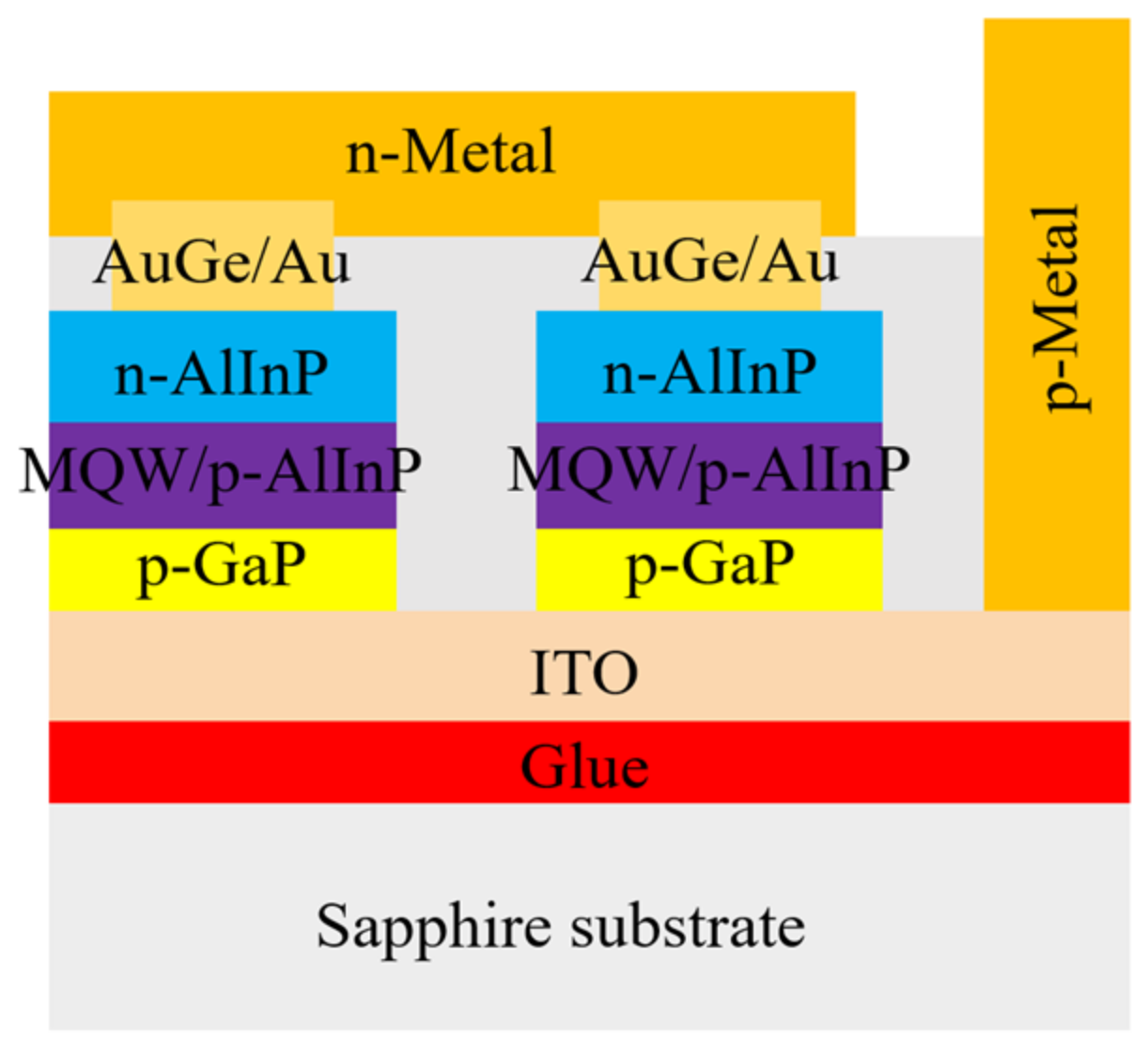

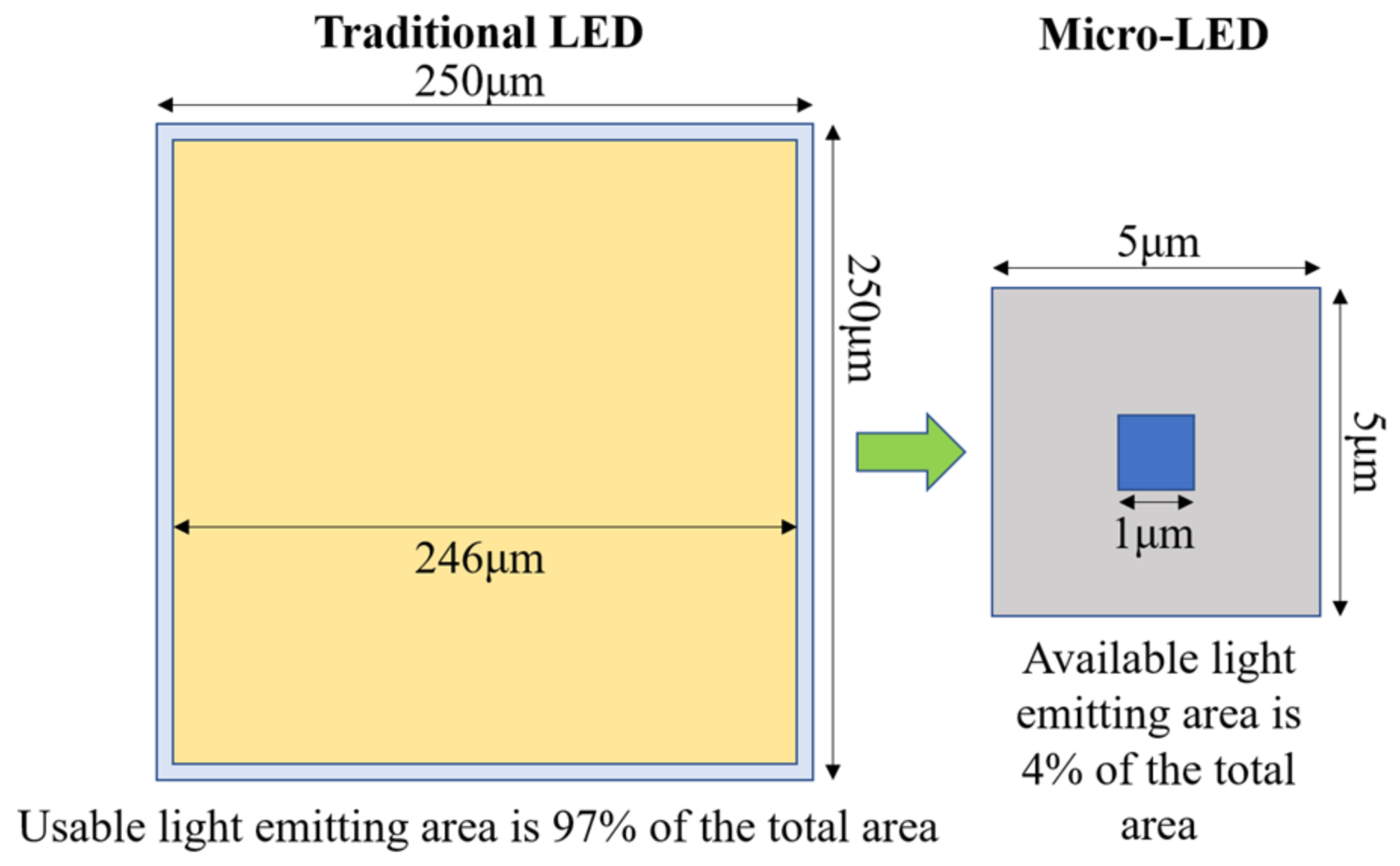
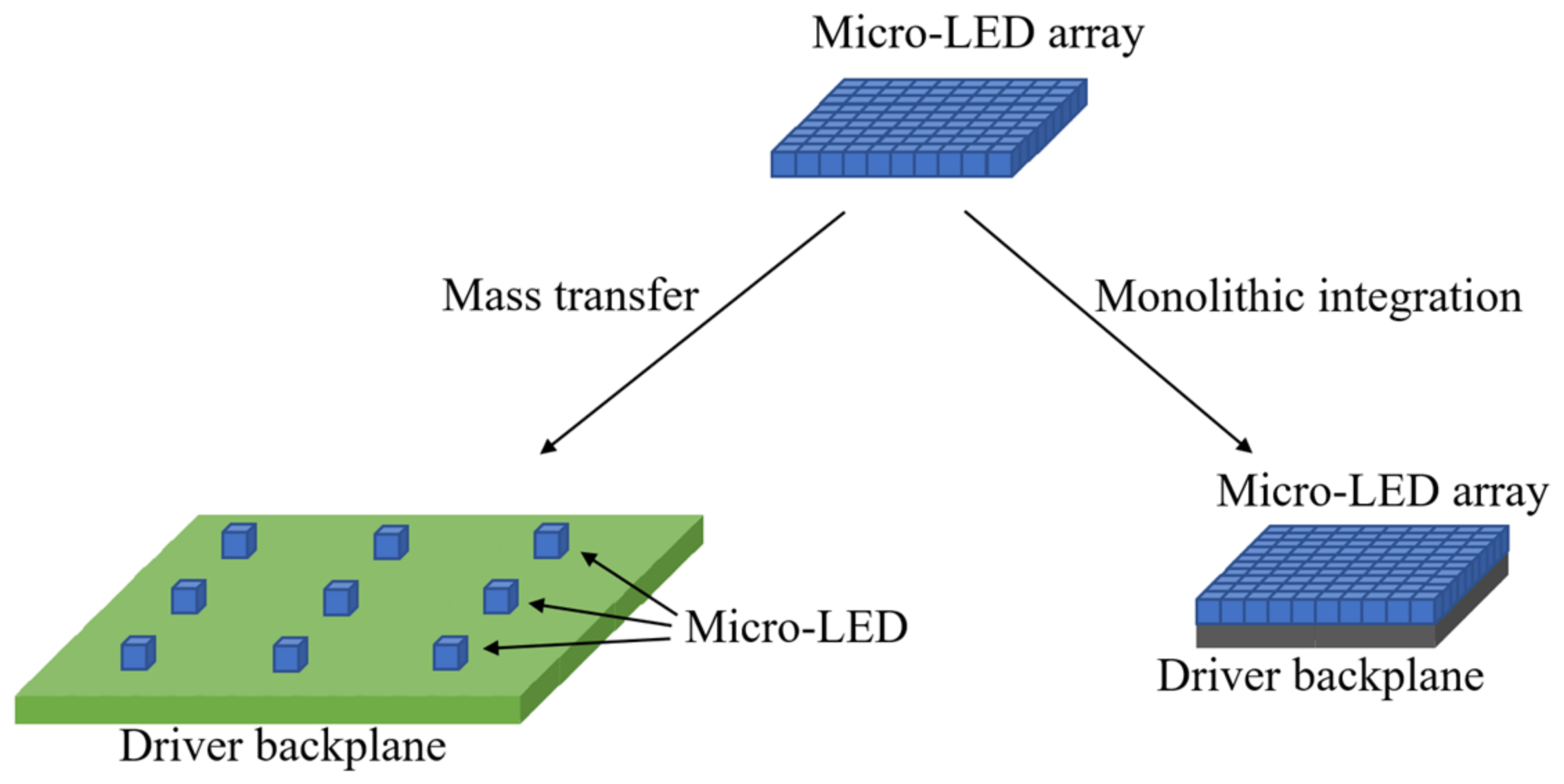
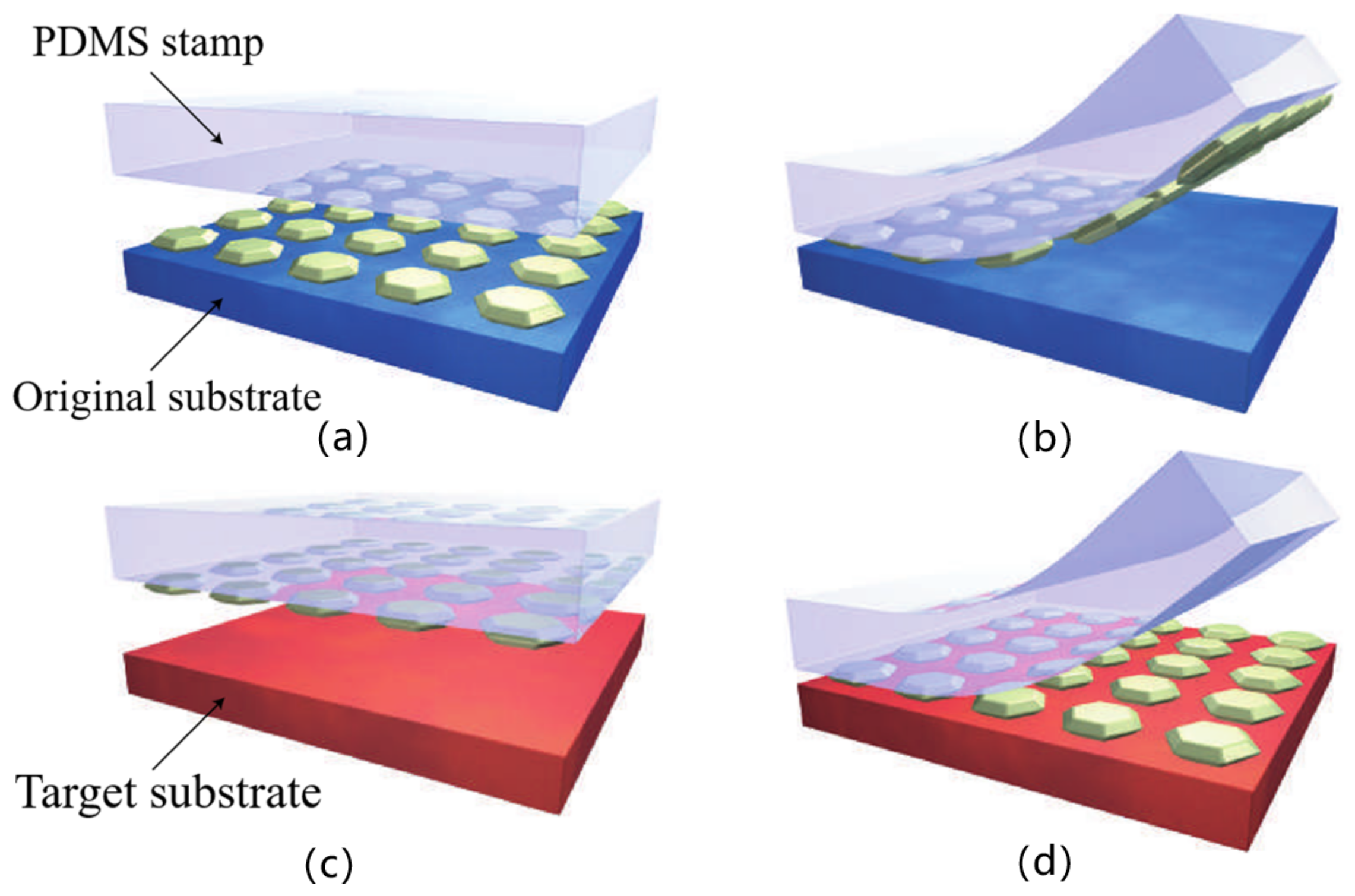
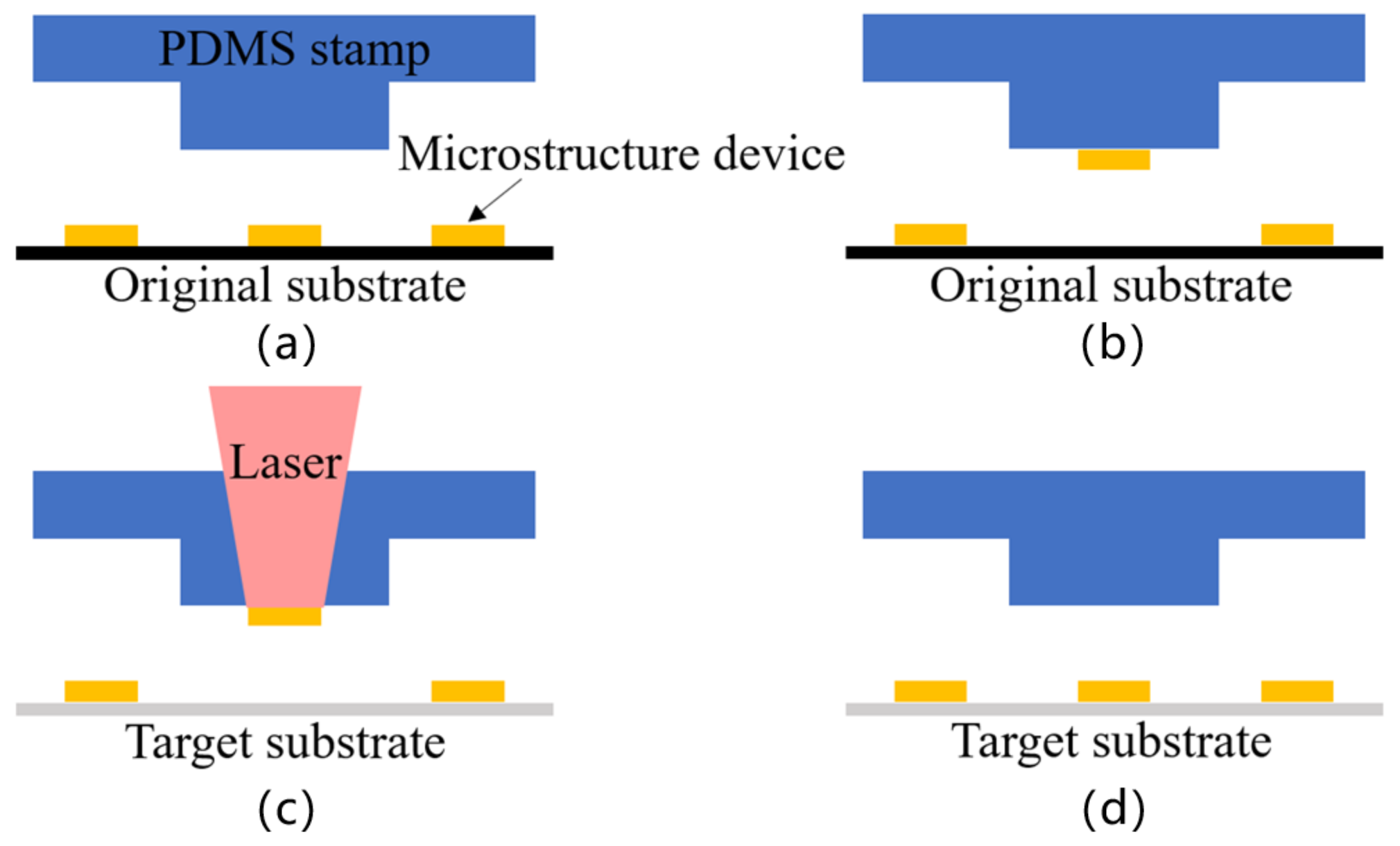
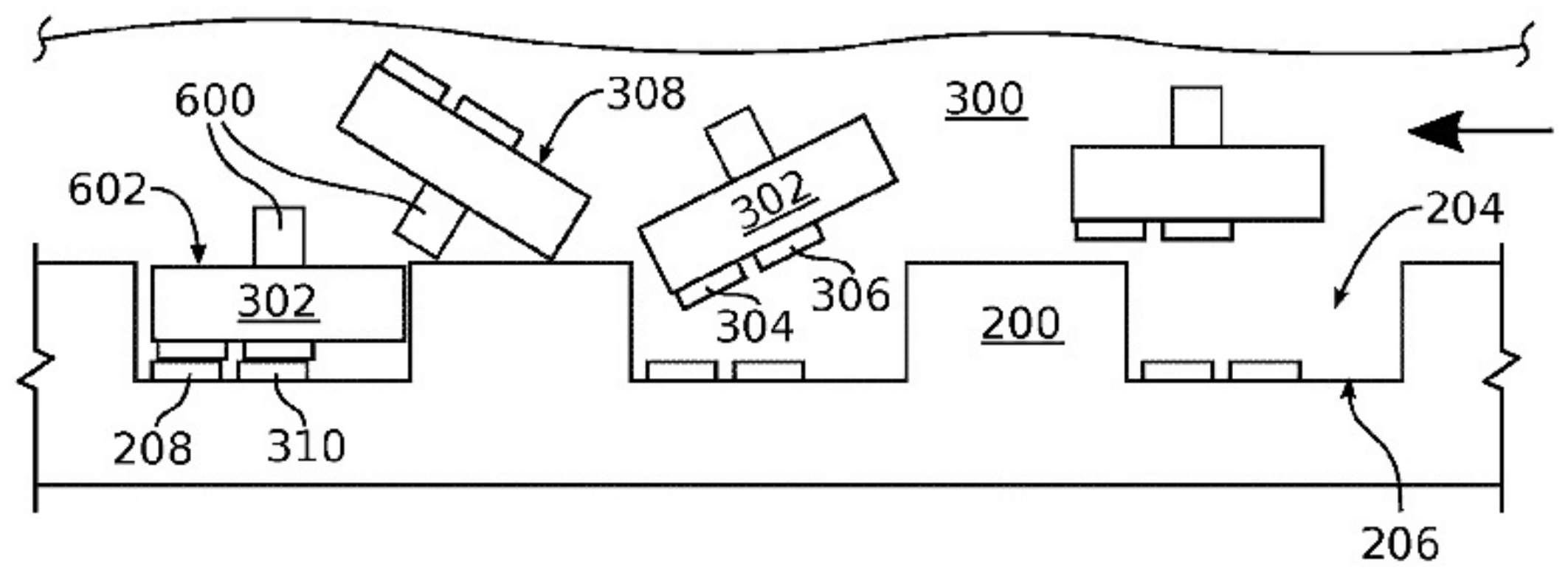

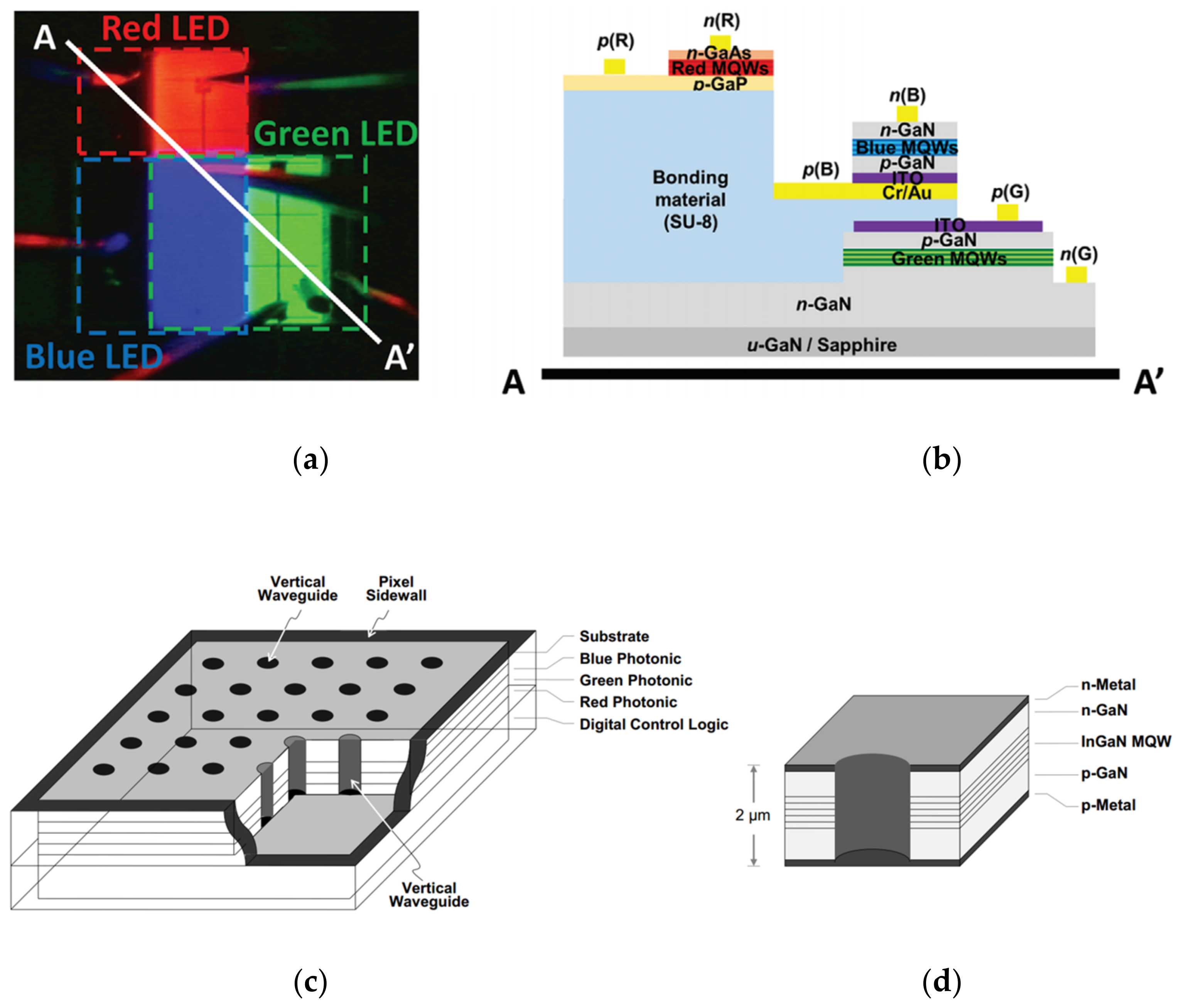



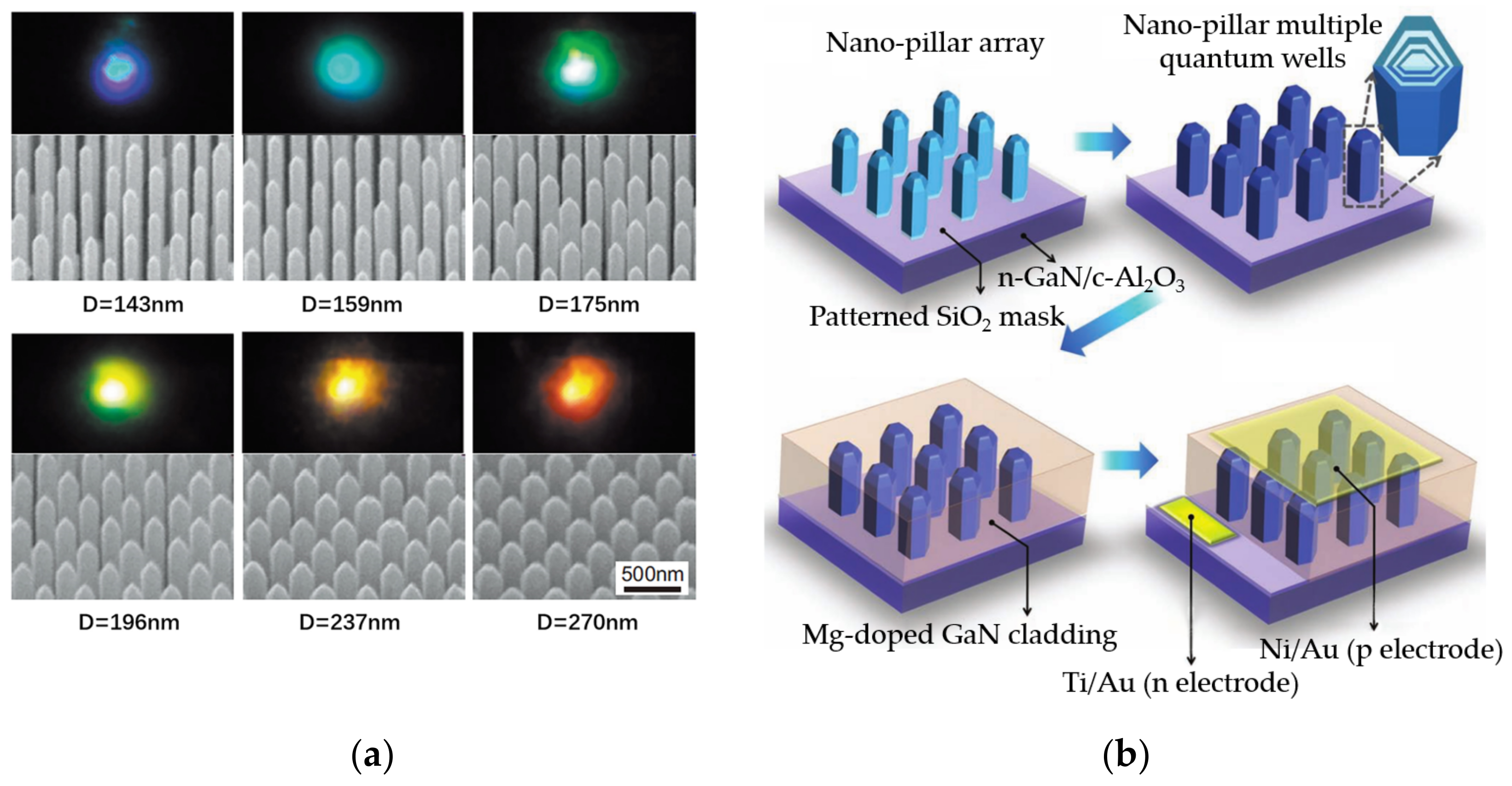
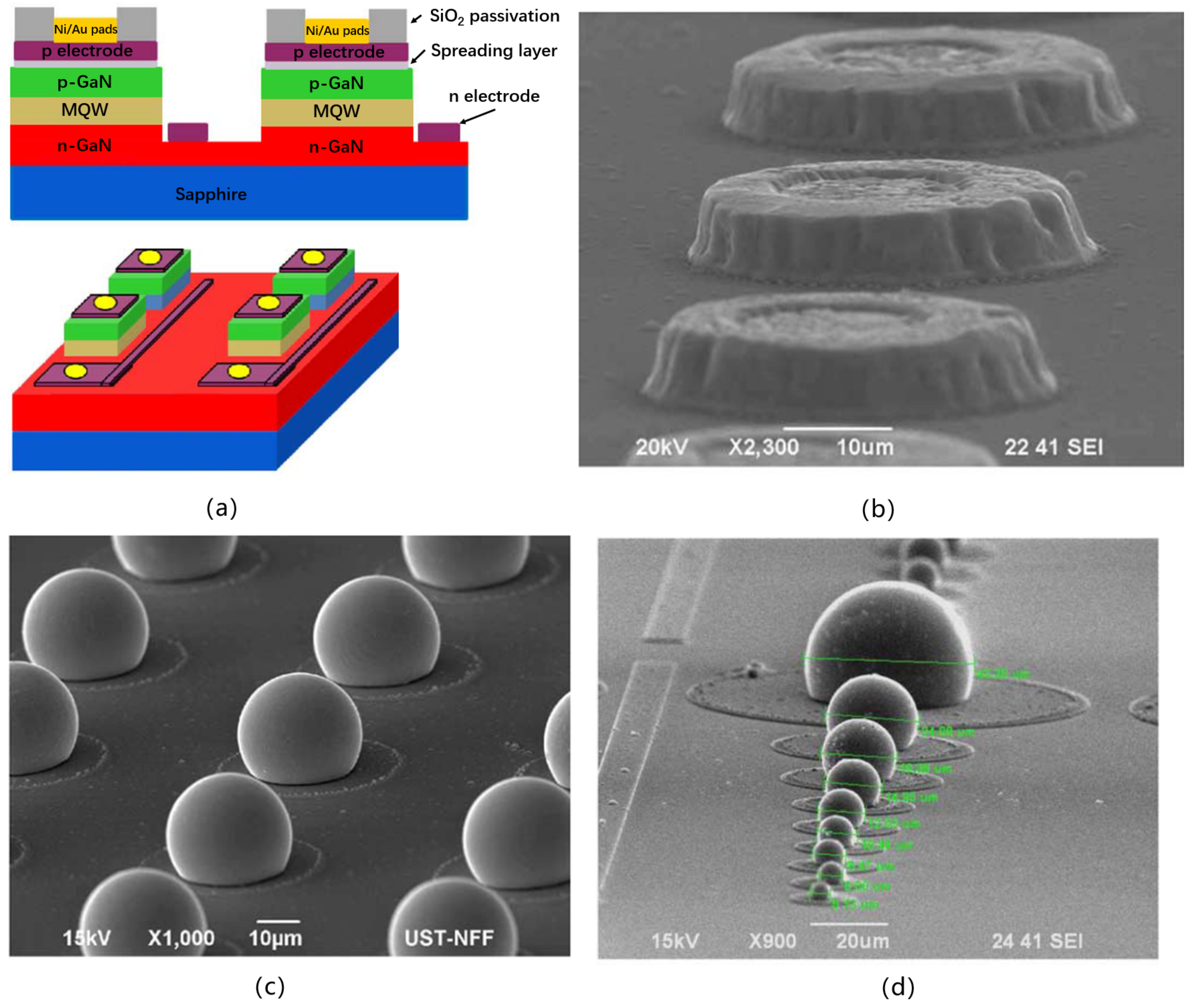
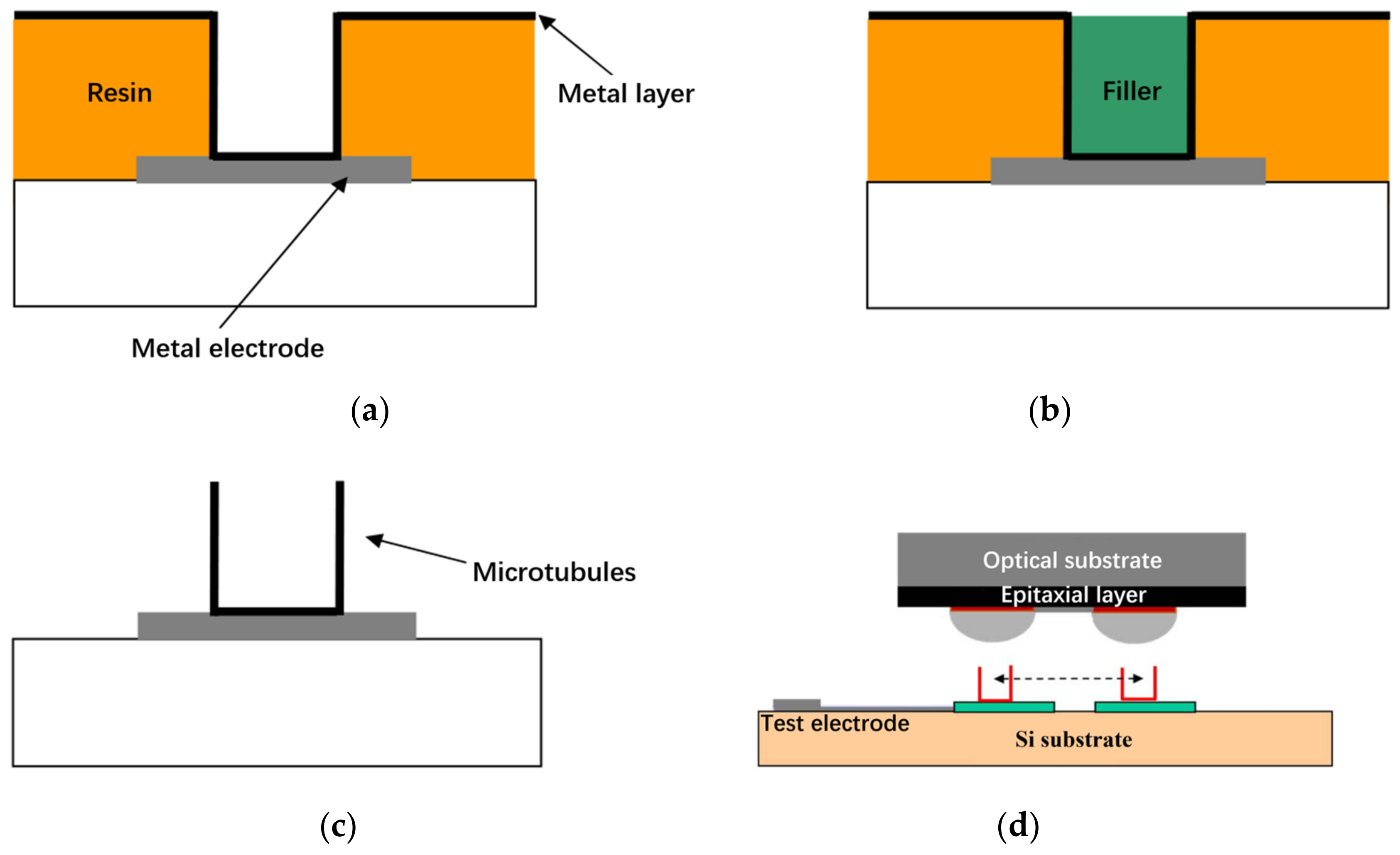
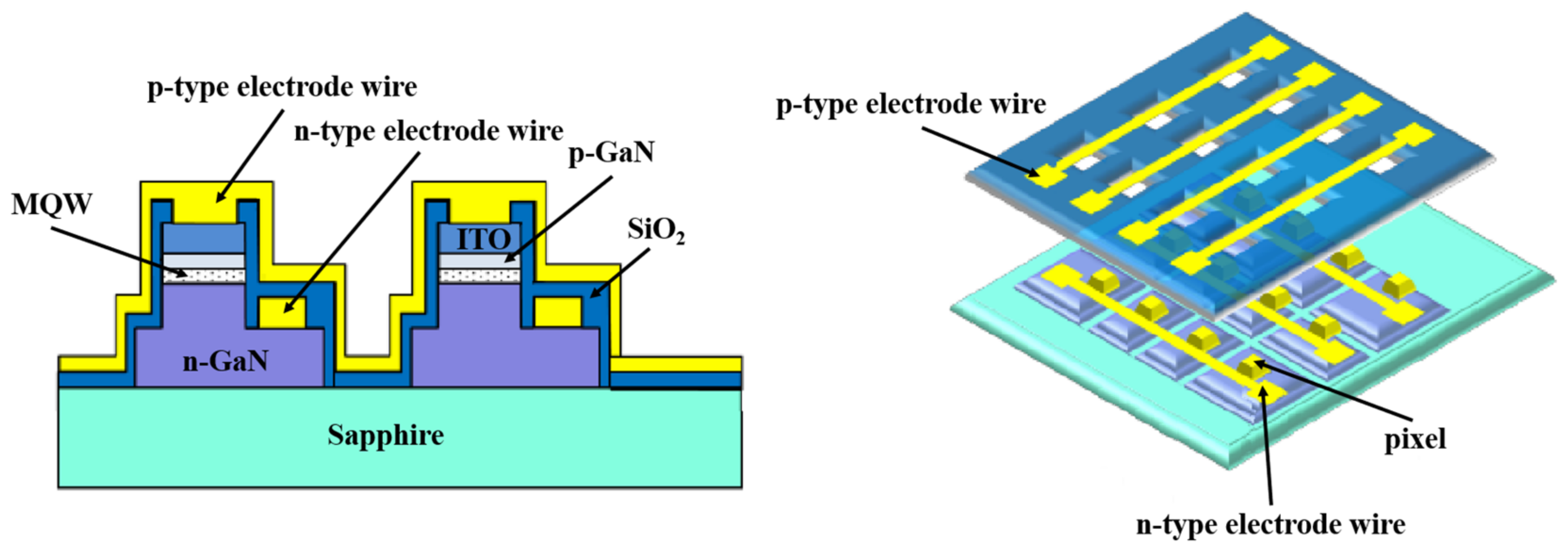
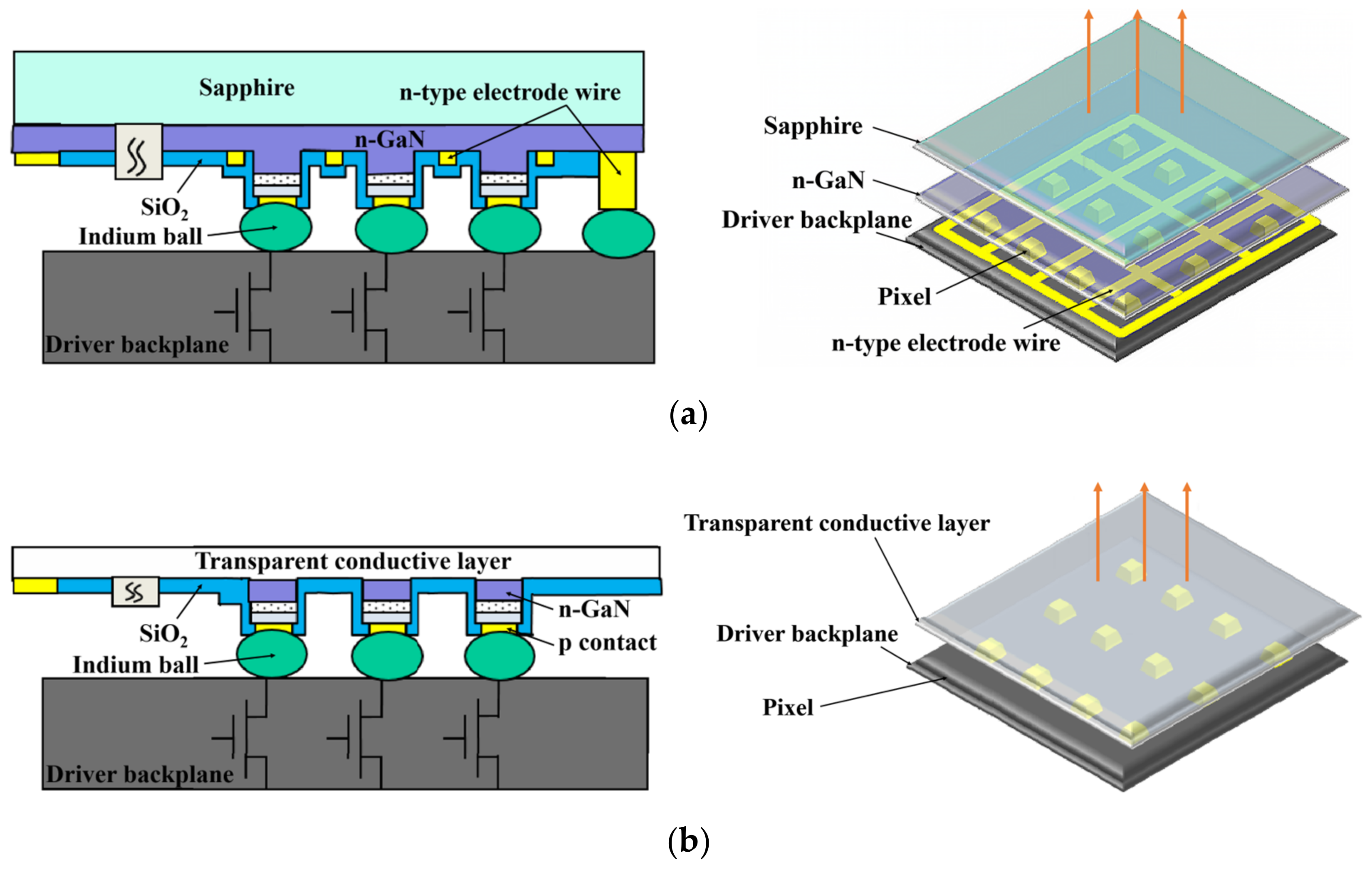
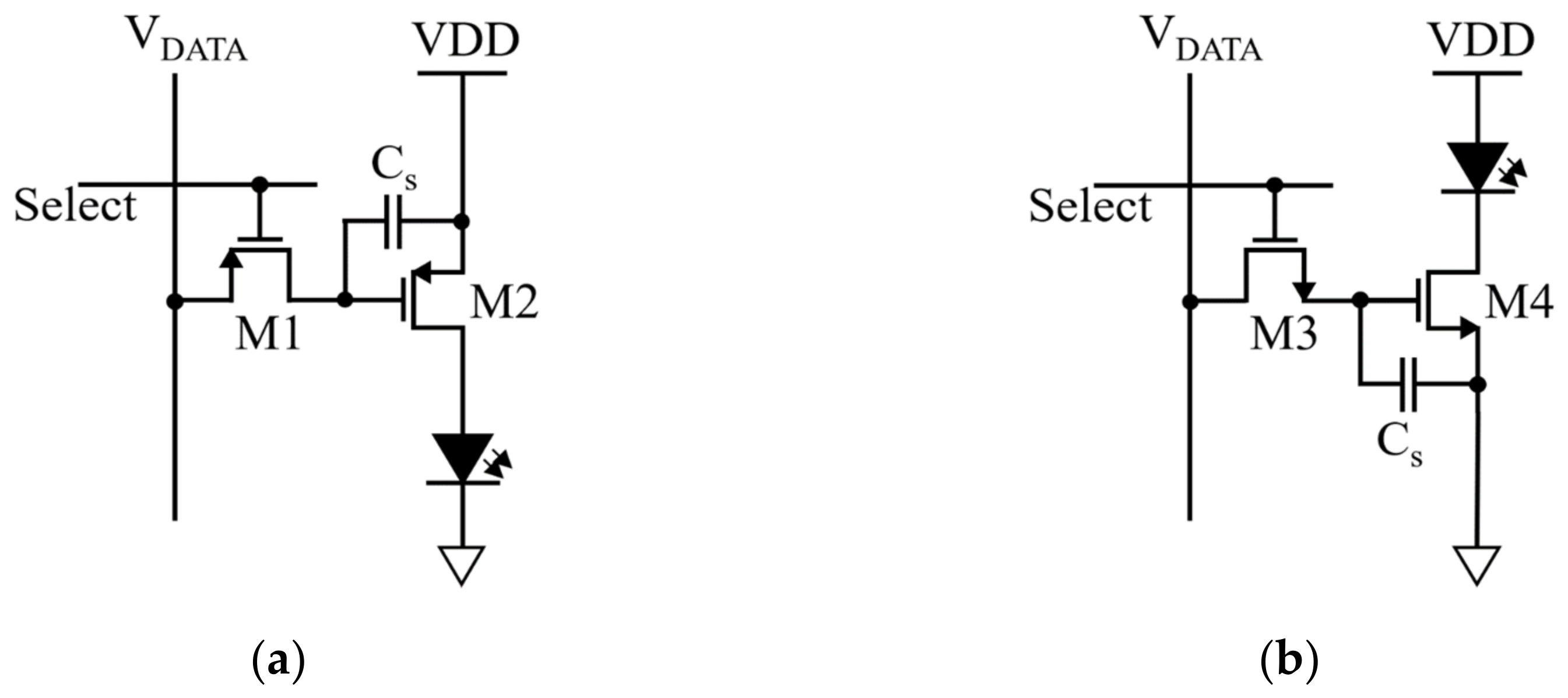
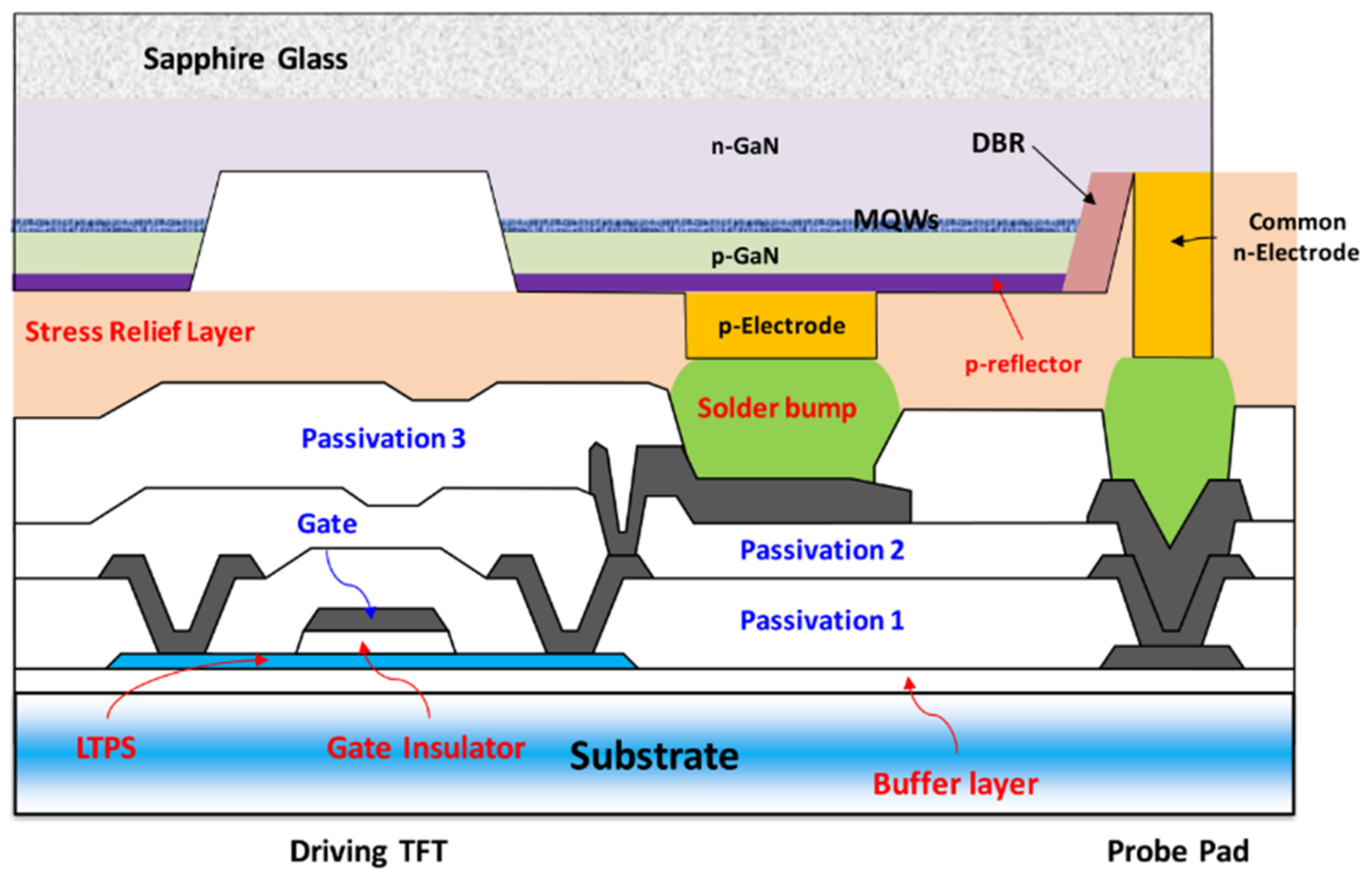
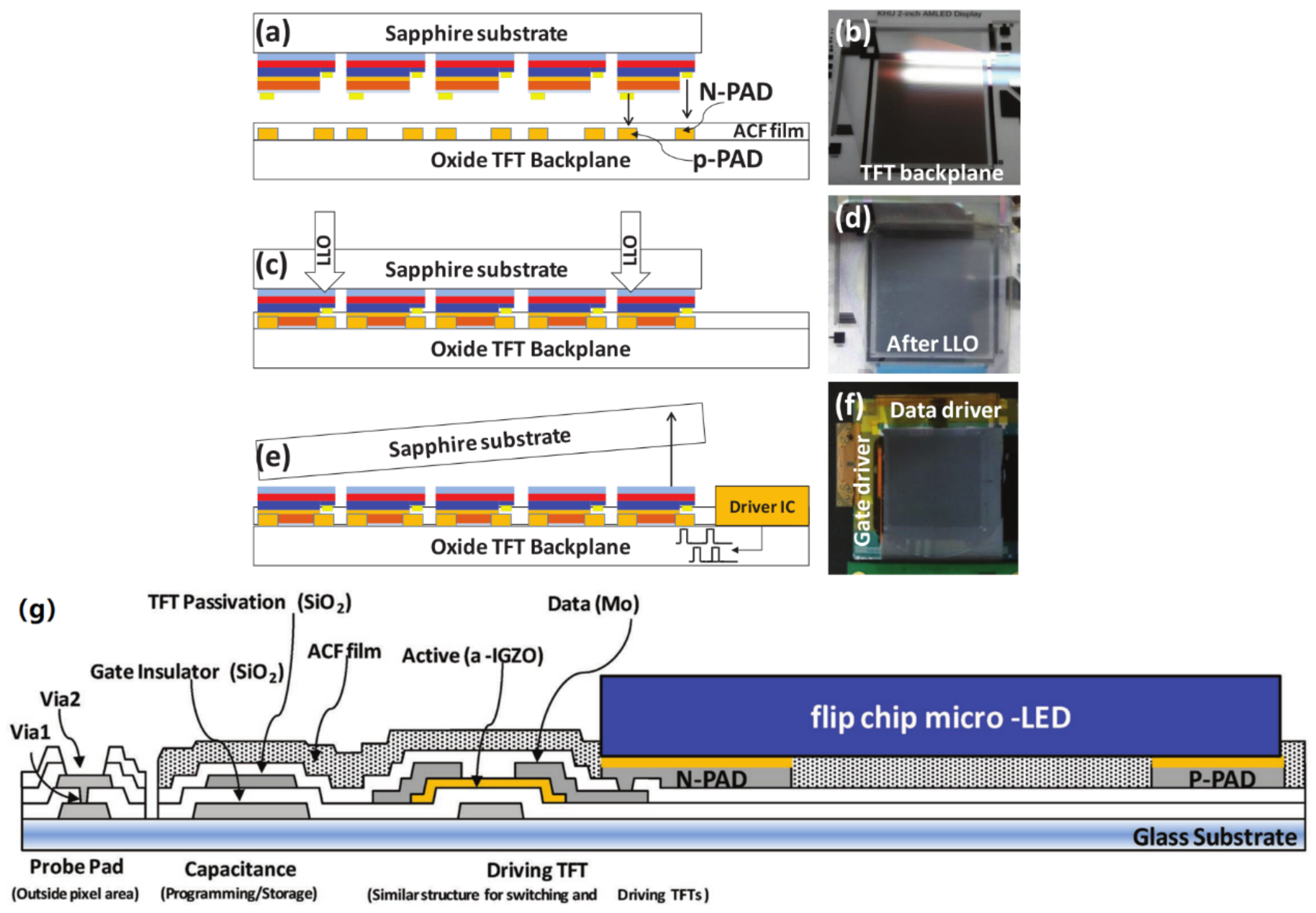
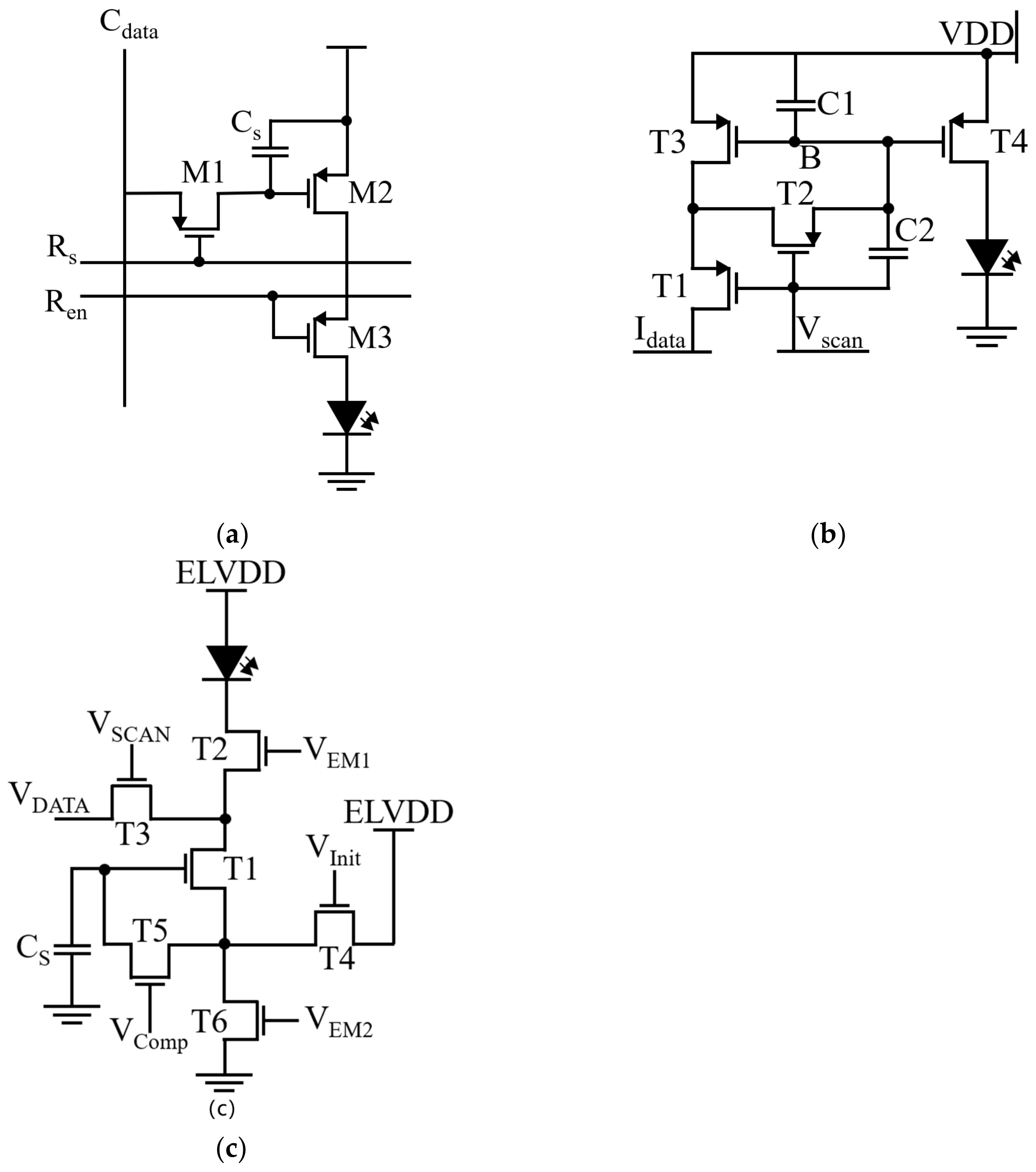
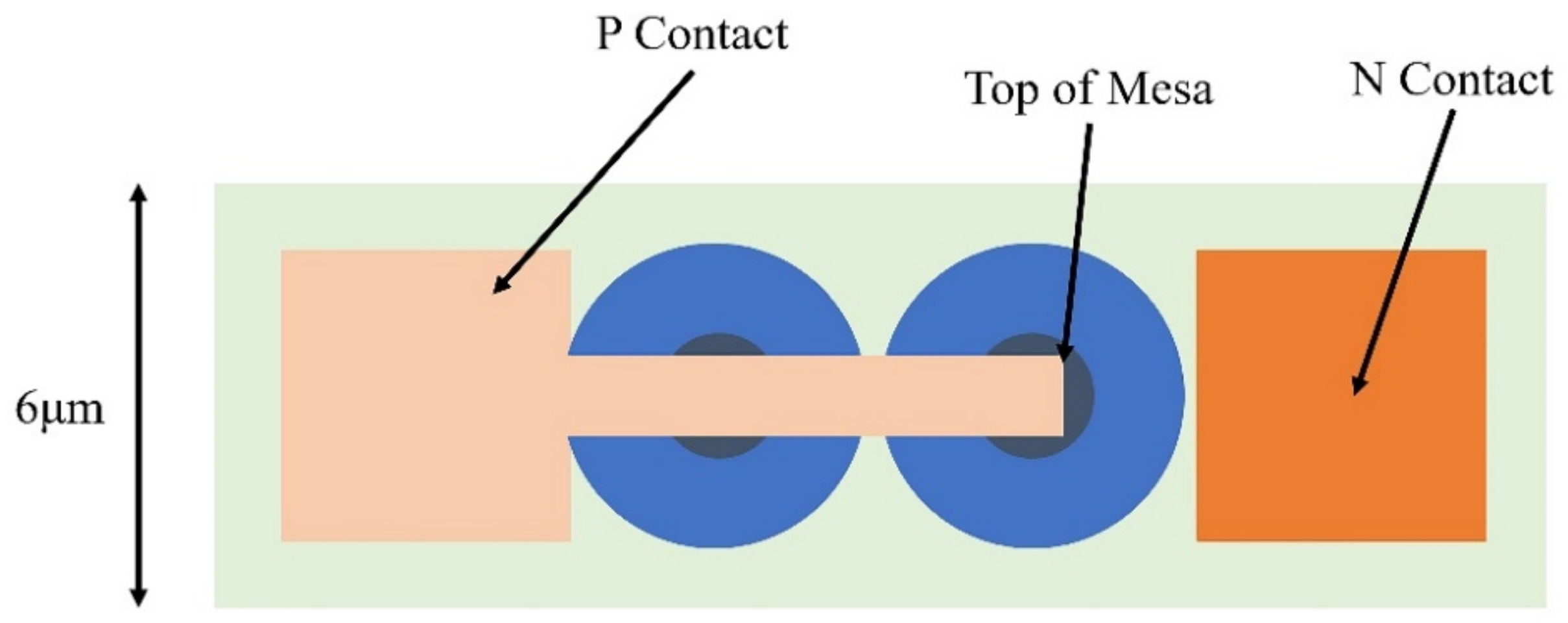
| Item | LCD | OLED | Micro-LED |
|---|---|---|---|
| Mechanism | Backlighting and color filter | Self-emissive | Self-emissive |
| Pixel density | Max. 1000 PPI | Max. 2500 PPI | Max. 30,000 PPI |
| Brightness | <7000 nits | <5000 nits | >1,000,000 nits |
| Contrast ratio | 5000:1 | >10,000:1 | >1,000,000:1 |
| Pixel size | Min. 32 µm | Min. 18 µm | Min. sub-micrometer |
| Compactness | Low | Medium | High |
| Operation temperature | −20–80 °C | −50–70 °C | −100–120 °C |
| Lifetime | Long | Medium | Long |
| Response time | Low (ms) | Medium (µs) | High (ns) |
| Environmental stability | High | Medium | High |
| Energy consumption | Medium | Medium | Low |
| Enhanced function | Medium | Medium | High |
| Flexibility | Low | High | Medium |
| Cost | Low | Low | High |
Disclaimer/Publisher’s Note: The statements, opinions and data contained in all publications are solely those of the individual author(s) and contributor(s) and not of MDPI and/or the editor(s). MDPI and/or the editor(s) disclaim responsibility for any injury to people or property resulting from any ideas, methods, instructions or products referred to in the content. |
© 2023 by the authors. Licensee MDPI, Basel, Switzerland. This article is an open access article distributed under the terms and conditions of the Creative Commons Attribution (CC BY) license (https://creativecommons.org/licenses/by/4.0/).
Share and Cite
Zhang, S.; Zheng, H.; Zhou, L.; Li, H.; Chen, Y.; Wei, C.; Wu, T.; Lv, W.; Zhang, G.; Zhang, S.; et al. Research Progress of Micro-LED Display Technology. Crystals 2023, 13, 1001. https://doi.org/10.3390/cryst13071001
Zhang S, Zheng H, Zhou L, Li H, Chen Y, Wei C, Wu T, Lv W, Zhang G, Zhang S, et al. Research Progress of Micro-LED Display Technology. Crystals. 2023; 13(7):1001. https://doi.org/10.3390/cryst13071001
Chicago/Turabian StyleZhang, Shenghao, Hua Zheng, Lv Zhou, Huadan Li, Yuanrui Chen, Chenchen Wei, Tao Wu, Wei Lv, Geng Zhang, Shaoqiang Zhang, and et al. 2023. "Research Progress of Micro-LED Display Technology" Crystals 13, no. 7: 1001. https://doi.org/10.3390/cryst13071001
APA StyleZhang, S., Zheng, H., Zhou, L., Li, H., Chen, Y., Wei, C., Wu, T., Lv, W., Zhang, G., Zhang, S., Gong, Z., Jia, B., Lin, H., Gao, Z., Xu, W., & Ning, H. (2023). Research Progress of Micro-LED Display Technology. Crystals, 13(7), 1001. https://doi.org/10.3390/cryst13071001












